Charles Lindbergh
Charles Augustus Lindbergh (February 4, 1902 – August 26, 1974) was an American aviator, military officer, author, inventor, and activist. At the age of 25 in 1927, he went from obscurity as a U.S. Air Mail pilot to instantaneous world fame by winning the Orteig Prize for making a nonstop flight from New York City to Paris. Lindbergh covered the 33 1⁄2-hour, 3,600-statute-mile (5,800 km) flight alone in a purpose-built, single-engine Ryan monoplane, the Spirit of St. Louis. Although not the first non-stop transatlantic flight, this was the first solo transatlantic flight, the first transatlantic flight between two major city hubs, and the longest transatlantic flight by almost 2,000 miles, thus it is widely considered a turning point in the development of aviation.
Charles Lindbergh | |
|---|---|
 Photo by Harris & Ewing | |
| Born | Charles Augustus Lindbergh February 4, 1902 |
| Died | August 26, 1974 (aged 72) Kipahulu, Maui, Hawaii, U.S. |
| Resting place | Palapala Ho'omau Church, Kipahulu, Maui, Hawaii |
| Nationality | |
| Other names |
|
| Education | Sidwell Friends School Redondo Union High School Little Falls High School University of Wisconsin–Madison (did not graduate) |
| Occupation | Aviator, author, inventor, explorer, activist |
| Known for | First solo transatlantic flight (1927) |
| Home town | Little Falls, Minnesota |
| Spouse(s) | Anne Morrow Lindbergh (1929–1974) (his death) |
| Children | With Anne Morrow Lindbergh: Charles Augustus Lindbergh Jr. Jon Lindbergh Land Morrow Lindbergh Anne Spencer Lindbergh (Perrin) Scott Lindbergh Reeve Lindbergh (Brown) With Brigitte Hesshaimer: Dyrk Hesshaimer Astrid Hesshaimer Bouteuil David Hesshaimer With Marietta Hesshaimer: Vago Hesshaimer Christoph Hesshaimer. With Valeska (surname unknown): a son (name unknown) a daughter (name unknown) |
| Parent(s) | Charles August Lindbergh Evangeline Lodge Land Lindbergh |
| Military career | |
| Allegiance | |
| Service/ | |
| Years of service | 1925–1941, 1954–1974 |
| Rank | |
| Awards | Medal of Honor (1927) Distinguished Flying Cross (1927) Congressional Gold Medal (1928) |
| Signature | _signatures.jpg) |
Lindbergh was an officer in the U.S. Army Air Corps Reserve, and he received the United States' highest military decoration, the Medal of Honor, for his transatlantic flight.[2] His achievement spurred interest in both commercial aviation and air mail, which revolutionized the aviation industry, and he devoted much time and effort to promoting such activity.
In March 1932, Lindbergh's infant son, Charles Jr., was kidnapped and murdered in what the American media called the "Crime of the Century". The case prompted the United States Congress to establish kidnapping as a federal crime if the kidnapper crosses state lines with a victim. By late 1935, the hysteria surrounding the case had driven the Lindbergh family into exile in Europe, from which they returned in 1939.
In the years before the United States entered World War II, his non-interventionist stance and statements about Jews led some to suspect he was a Nazi sympathizer, although Lindbergh never publicly stated support for Nazi Germany. He opposed not only the intervention of the United States, but also the provision of aid to the United Kingdom.[3] He supported the anti-war America First Committee and resigned his commission in the U.S. Army Air Forces in April 1941 after President Franklin Roosevelt publicly rebuked him for his views. In September 1941, Lindbergh gave an address stating that the British, the Jews and the Roosevelt administration were the "three most important groups" pressing for greater American involvement in the war. He also said capitalists, intellectuals, American Anglophiles, and Communists were all agitating for war.[4]
Lindbergh publicly supported the U.S. war effort after the Japanese attack on Pearl Harbor and the subsequent German declaration of war against the United States. He flew 50 missions in the Pacific Theater of World War II as a civilian consultant,[5] but did not take up arms against Germany, and Roosevelt refused to reinstate his Air Corps colonel's commission. In his later years, Lindbergh became a prolific author, international explorer, inventor, and environmentalist.
Rise to fame
Early childhood
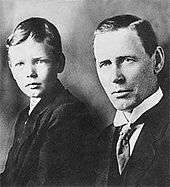
Lindbergh was born in Detroit, Michigan on February 4, 1902 and spent most of his childhood in Little Falls, Minnesota and Washington, D.C. He was the third child of Charles August Lindbergh (birth name Carl Månsson; 1859–1924) who had emigrated from Sweden to Melrose, Minnesota as an infant, and his only child with his second wife, Evangeline Lodge Land Lindbergh (1876–1954), of Detroit. Charles' parents separated in 1909 when he was seven.[6] Lindbergh's father, a U.S. Congressman (R-MN-6) from 1907 to 1917, was one of the few Congressmen to oppose the entry of the U.S. into World War I (although his Congressional term ended one month prior to the House of Representatives voting to declare war on Germany).[7] His book, Why Is Your Country at War, which criticized the US' entry into the first World War, was seized by federal agents under the Comstock Act. It was later posthumously reprinted and issued in 1934, under the title Your Country at War, and What Happens to You After a War.[8]
Lindbergh's mother was a chemistry teacher at Cass Technical High School in Detroit and later at Little Falls High School, from which her son graduated on June 5, 1918. Lindbergh also attended over a dozen other schools from Washington, D.C., to California, during his childhood and teenage years (none for more than a year or two), including the Force School and Sidwell Friends School while living in Washington with his father, and Redondo Union High School in Redondo Beach, California, while living there with his mother.[9] Although he enrolled in the College of Engineering at the University of Wisconsin–Madison in late 1920, Lindbergh dropped out in the middle of his sophomore year and then went to Lincoln, Nebraska, in March 1922 to begin flight training.[10]
Early aviation career

From an early age, Lindbergh had exhibited an interest in the mechanics of motorized transportation, including his family's Saxon Six automobile, and later his Excelsior motorbike. By the time he started college as a mechanical engineering student, he had also become fascinated with flying, though he "had never been close enough to a plane to touch it".[11] After quitting college in February 1922, Lindbergh enrolled at the Nebraska Aircraft Corporation's flying school in Lincoln and flew for the first time on April 9, as a passenger in a two-seat Lincoln Standard "Tourabout" biplane trainer piloted by Otto Timm.[12]
A few days later, Lindbergh took his first formal flying lesson in that same machine, though he was never permitted to solo because he could not afford to post the requisite damage bond.[13] To gain flight experience and earn money for further instruction, Lindbergh left Lincoln in June to spend the next few months barnstorming across Nebraska, Kansas, Colorado, Wyoming, and Montana as a wing walker and parachutist. He also briefly worked as an airplane mechanic at the Billings, Montana, municipal airport.[14][15]
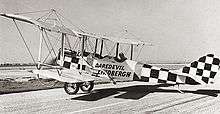
Lindbergh left flying with the onset of winter and returned to his father's home in Minnesota.[16] His return to the air and first solo flight did not come until half a year later in May 1923 at Souther Field in Americus, Georgia, a former Army flight training field, where he had come to buy a World War I surplus Curtiss JN-4 "Jenny" biplane. Though Lindbergh had not touched an airplane in more than six months, he had already secretly decided he was ready to take to the air by himself. After a half-hour of dual time with a pilot who was visiting the field to pick up another surplus JN-4, Lindbergh flew solo for the first time in the Jenny he had just purchased for $500.[17][18] After spending another week or so at the field to "practice" (thereby acquiring five hours of "pilot in command" time), Lindbergh took off from Americus for Montgomery, Alabama, some 140 miles to the west, for his first solo cross-country flight.[19] He went on to spend much of the rest of 1923 engaged in almost nonstop barnstorming under the name of "Daredevil Lindbergh". Unlike the previous year, this time Lindbergh flew in his "own ship" as pilot.[20][21] A few weeks after leaving Americus, the young airman also achieved another key aviation milestone when he made his first flight at night near Lake Village, Arkansas.[22]
While Lindbergh was barnstorming in Lone Rock, Wisconsin, on two occasions he flew a local physician across the Wisconsin River to emergency calls that were otherwise unreachable due to flooding.[23] He broke his propeller several times while landing, and on June 3, 1923 he was grounded for a week when he ran into a ditch in Glencoe, Minnesota while flying his father—then running for the U.S. Senate—to a campaign stop. In October, Lindbergh flew his Jenny to Iowa, where he sold it to a flying student. After selling the Jenny, Lindbergh returned to Lincoln by train. There, he joined Leon Klink and continued to barnstorm through the South for the next few months in Klink's Curtiss JN-4C "Canuck" (the Canadian version of the Jenny). Lindbergh also "cracked up" this aircraft once when his engine failed shortly after take-off in Pensacola, Florida, but again he managed to repair the damage himself.[24]
Following a few months of barnstorming through the South, the two pilots parted company in San Antonio, Texas, where Lindbergh reported to Brooks Field on March 19, 1924, to begin a year of military flight training with the United States Army Air Service there (and later at nearby Kelly Field).[25] Lindbergh had his most serious flying accident on March 5, 1925, eight days before graduation, when a midair collision with another Army S.E.5 during aerial combat maneuvers forced him to bail out.[26] Only 18 of the 104 cadets who started flight training a year earlier remained when Lindbergh graduated first overall in his class in March 1925, thereby earning his Army pilot's wings and a commission as a 2nd Lieutenant in the Air Service Reserve Corps.[27][N 1]
Lindbergh later said that this year was critical to his development as both a focused, goal-oriented individual and as an aviator.[N 2] The Army did not need additional active-duty pilots, however, so immediately following graduation Lindbergh returned to civilian aviation as a barnstormer and flight instructor, although as a reserve officer he also continued to do some part-time military flying by joining the 110th Observation Squadron, 35th Division, Missouri National Guard, in St. Louis. He was soon promoted to 1st Lieutenant, and to captain in July 1926.[30]
Air Mail pilot
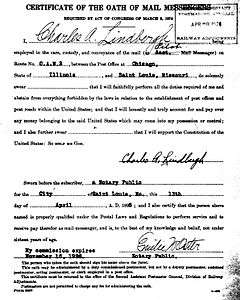
In October 1925, Lindbergh was hired by the Robertson Aircraft Corporation (RAC) at the Lambert-St. Louis Flying Field in Anglum, MO (where he had been working as a flight instructor) to first lay out and then serve as chief pilot for the newly designated 278-mile (447 km) Contract Air Mail Route #2 (CAM-2) to provide service between St. Louis and Chicago (Maywood Field) with two intermediate stops in Springfield and Peoria, Illinois.[31] Lindbergh and three other RAC pilots, Philip R. Love, Thomas P. Nelson, and Harlan A. "Bud" Gurney, flew the mail over CAM-2 in a fleet of four modified war-surplus de Havilland DH-4 biplanes.
Just before signing on to fly with CAM, Lindbergh had applied to serve as a pilot on Richard E. Byrd's North Pole expedition, but apparently his bid came too late.[32]
On April 13, 1926, Lindbergh executed the Post Office Department's Oath of Mail Messengers,[33] and two days later he opened service on the new route. Twice combinations of bad weather, equipment failure, and fuel exhaustion forced him to bail out on night approach to Chicago;[34][35] both times he reached the ground without serious injury and immediately set about ensuring his cargo was located and sent on with minimum delay.[35][36] In mid-February 1927 he left for San Diego, California, to oversee design and construction of the Spirit of St. Louis.[37]
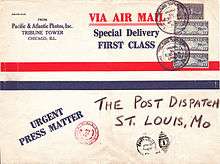
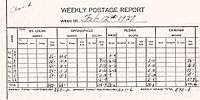
New York–Paris flight
Orteig Prize
The world's first nonstop transatlantic flight (though at 1,890 mi, or 3,040 km, far shorter than Lindbergh's 3,600 mi, or 5,800 km, flight) was made eight years earlier by British aviators John Alcock and Arthur Whitten Brown, in a modified Vickers Vimy IV bomber. They left St. John's, Newfoundland on June 14, 1919 and arrived in Ireland, the following day.[38]
Around the same time, French-born New York hotelier Raymond Orteig was approached by Augustus Post, secretary of the Aero Club of America, and prompted to put up a $25,000 award for the first successful nonstop transatlantic flight specifically between New York City and Paris (in either direction) within five years after its establishment. When that time limit lapsed in 1924 without a serious attempt, Orteig renewed the offer for another five years, this time attracting a number of well-known, highly experienced, and well-financed contenders[39]—none of whom was successful. On September 21, 1926 World War I French flying ace René Fonck's Sikorsky S-35 crashed on takeoff from Roosevelt Field in New York. U.S. Naval aviators Noel Davis and Stanton H. Wooster were killed at Langley Field, Virginia on April 26, 1927, while testing their Keystone Pathfinder. On May 8 French war heroes Charles Nungesser and François Coli departed Paris – Le Bourget Airport in the Levasseur PL 8 seaplane L'Oiseau Blanc; they disappeared somewhere in the Atlantic after last being seen crossing the west coast of Ireland.[40]
American air racer Clarence D. Chamberlin and Arctic explorer Richard E. Byrd were also in the race.
Spirit of St. Louis
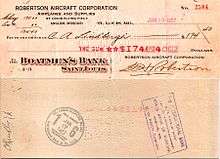
Financing the operation of the historic flight was a challenge due to Lindbergh's obscurity, but two St. Louis businessmen eventually obtained a $15,000 bank loan. Lindbergh contributed $2,000 ($27,280.45 in 2017)[41] of his own money from his salary as an Air Mail pilot and another $1,000 was donated by RAC. The total of $18,000 was far less than what was available to Lindbergh's rivals.[42]
The group tried to buy an "off-the-peg" single or multiengine monoplane from Wright Aeronautical, then Travel Air, and finally the newly formed Columbia Aircraft Corporation, but all insisted on selecting the pilot as a condition of sale.[43][44][45] Finally the much smaller Ryan Aircraft Company of San Diego agreed to design and build a custom monoplane for $10,580, and on February 25 a deal was formally closed.[46] Dubbed the Spirit of St. Louis, the fabric-covered, single-seat, single-engine "Ryan NYP" high-wing monoplane (CAB registration: N-X-211) was designed jointly by Lindbergh and Ryan's chief engineer Donald A. Hall.[47] The Spirit flew for the first time just two months later, and after a series of test flights Lindbergh took off from San Diego on May 10. He went first to St. Louis, then on to Roosevelt Field on New York's Long Island.[48]
Flight
.jpg)
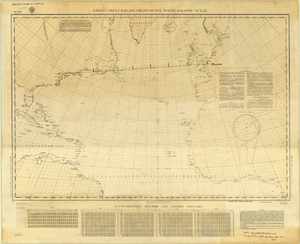
In the early morning of Friday, May 20, 1927, Lindbergh took off from Roosevelt Field, Long Island[49][50] His monoplane was loaded with 450 U.S. gallons (1,704 liters) of fuel that was strained repeatedly to avoid fuel line blockage. The fully loaded aircraft weighed 5,135 lb (2,329 kg), with takeoff hampered by a muddy, rain-soaked runway. Lindbergh's monoplane was powered by a J-5C Wright Whirlwind radial engine and gained speed very slowly during its 7:52 a.m. takeoff, but cleared telephone lines at the far end of the field "by about twenty feet [six meters] with a fair reserve of flying speed".[51]
Over the next 33 1⁄2 hours, Lindbergh and the Spirit faced many challenges, which included skimming over storm clouds at 10,000 ft (3,000 m) and wave tops at as low as 10 ft (3.0 m). The aircraft fought icing, flew blind through fog for several hours, and Lindbergh navigated only by dead reckoning (he was not proficient at navigating by the sun and stars and he rejected radio navigation gear as heavy and unreliable). He was fortunate that the winds over the Atlantic cancelled each other out, giving him zero wind drift – and thus accurate navigation during the long flight over featureless ocean.[52][53] He landed at Le Bourget Aerodrome[54] at 10:22 p.m. on Saturday, May 21.[55] The airfield was not marked on his map and Lindbergh knew only that it was some seven miles northeast of the city; he initially mistook it for some large industrial complex because of the bright lights spreading out in all directions—in fact the headlights of tens of thousands of spectators' cars caught in "the largest traffic jam in Paris history" in their attempt to be present for Lindbergh's landing.[56]
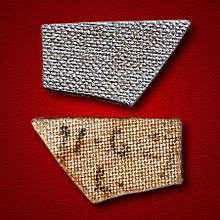
A crowd estimated at 150,000 stormed the field, dragged Lindbergh out of the cockpit, and carried him around above their heads for "nearly half an hour". Some damage was done to the Spirit (especially to the fine linen, silver-painted fabric covering on the fuselage) by souvenir hunters before pilot and plane reached the safety of a nearby hangar with the aid of French military fliers, soldiers, and police.[57]
Lindbergh's flight was certified by the National Aeronautic Association based on the readings from a sealed barograph placed in the Spirit.[58][59]
Fame
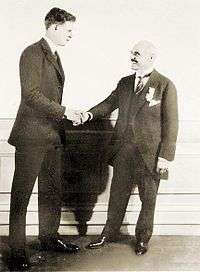
Lindbergh received unprecedented adulation after his historic flight. People were "behaving as though Lindbergh had walked on water, not flown over it".[61]:17 The New York Times printed an above the fold, page-wide headline: "LINDBERGH DOES IT!"[62] His mother's house in Detroit was surrounded by a crowd estimated at about 1,000.[63] Countless newspapers, magazines, and radio shows wanted to interview him, and he was flooded with job offers from companies, think tanks, and universities.
The French Foreign Office flew the American flag, the first time it had saluted someone who wasn't a head of state.[64] Lindbergh also made a series of brief flights to Belgium and Great Britain in the Spirit before returning to the United States. Gaston Doumergue, the President of France, bestowed the French Légion d'honneur on Lindbergh,[65] and on his arrival back in the United States aboard the U.S. Navy cruiser USS Memphis (CL-13) on June 11, 1927, a fleet of warships and multiple flights of military aircraft escorted him up the Potomac River to the Washington Navy Yard, where President Calvin Coolidge awarded him the Distinguished Flying Cross.[66][67] Lindbergh received the first award of this medal, but it violated the authorizing regulation. Coolidge's own executive order, published in March 1927, required recipients to perform their feats of airmanship "while participating in an aerial flight as part of the duties incident to such membership [in the Organized Reserves]," which Lindbergh very clearly failed to satisfy.[68][69] The U.S. Post Office Department issued a 10-cent Air Mail stamp (Scott C-10) depicting the Spirit and a map of the flight.
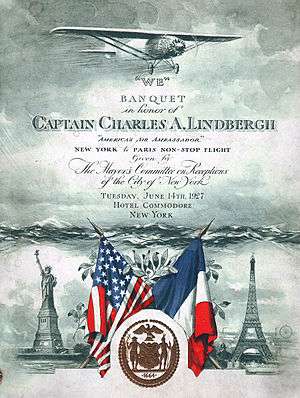
Lindbergh flew from Washington, D.C. to New York City on June 13, arriving in lower Manhattan. He traveled up the Canyon of Heroes to City Hall, where he was received by Mayor Jimmy Walker. A ticker-tape parade[71] followed to Central Park Mall, where he was honored at another ceremony hosted by New York Governor Al Smith and attended by a crowd of 200,000. Some 4,000,000 people saw Lindbergh that day.[72][73][74] That evening, Lindbergh was accompanied by his mother and Mayor Walker when he was the guest of honor at a 500-guest banquet and dance held at Clarence MacKay's Long Island estate, Harbor Hill.[75]
The following night, Lindbergh was honored with a grand banquet at the Hotel Commodore given by the Mayor's Committee on Receptions of the City of New York and attended by some 3,700 people.[76] He was officially awarded the check for the prize on June 16.[60]
On July 18, 1927, Lindbergh was promoted to the rank of colonel in the Air Corps of the Officers Reserve Corps of the U.S. Army.[77]
On December 14, 1927, a Special Act of Congress awarded Lindbergh the Medal of Honor, despite the fact that it was almost always awarded for heroism in combat.[78] It was presented to Lindbergh by President Coolidge at the White House on March 21.[79] Curiously, the medal contradicted Coolidge's earlier executive order directing that "not more than one of the several decorations authorized by Federal law will be awarded for the same act of heroism or extraordinary achievement" (Lindbergh was recognized for the same act with both the Medal of Honor and the Distinguished Flying Cross).[80] The statute authorizing the award was also criticized for apparently violating procedure; House legislators reportedly neglected to have their votes counted.[81] Similar noncombat awards of the Medal of Honor were also authorized by special statutes and awarded to naval aviators Richard E. Byrd and Floyd Bennett, as well as arctic explorer Adolphus W. Greely. In addition, the Medal of Honor awarded to General Douglas MacArthur was reportedly based on the Lindbergh precedent, although MacArthur notably lacked implementing legislation, which probably rendered his award unlawful.[82]
Lindbergh was honored as the first Time magazine "Man of the Year" when he appeared on that magazine's cover at age 25 January 2, 1928; he remains the youngest Man of the Year ever.[83] The winner of the 1930 Best Woman Aviator of the Year Award, Elinor Smith Sullivan, said that before Lindbergh's flight,
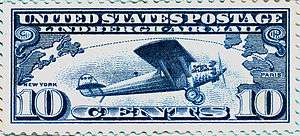
People seemed to think we [aviators] were from outer space or something. But after Charles Lindbergh's flight, we could do no wrong. It's hard to describe the impact Lindbergh had on people. Even the first walk on the moon doesn't come close. The twenties was such an innocent time, and people were still so religious—I think they felt like this man was sent by God to do this. And it changed aviation forever because all of a sudden the Wall Streeters were banging on doors looking for airplanes to invest in. We'd been standing on our heads trying to get them to notice us but after Lindbergh, suddenly everyone wanted to fly, and there weren't enough planes to carry them.[84]
Autobiography and tours
Barely two months after Lindbergh arrived in Paris, G. P. Putnam's Sons published his 318-page autobiography "WE", which was the first of 15 books he eventually wrote or to which he made significant contributions. The company was run by aviation enthusiast George P. Putnam.[85] The dustjacket notes said that Lindbergh wanted to share the "story of his life and his transatlantic flight together with his views on the future of aviation", and that "WE" referred to the "spiritual partnership" that had developed "between himself and his airplane during the dark hours of his flight".[86][87] But Putnam's had selected the title without Lindbergh's knowledge, and he complained, "we" actually referred to himself and his St. Louis financial backers, though his frequent unconscious use of the phrase seemed to suggest otherwise.[88]
"WE" was soon translated into most major languages and sold more than 650,000 copies in the first year, earning Lindbergh more than $250,000. Its success was considerably aided by Lindbergh's three-month, 22,350-mile (35,970 km) tour of the United States in the Spirit on behalf of the Daniel Guggenheim Fund for the Promotion of Aeronautics. Between July 20 and October 23, 1927 Lindbergh visited 82 cities in all 48 states, delivered 147 speeches, rode 1,290 mi (2,080 km) in parades,[88][N 3] and was seen by more than 30 million Americans, one quarter of the nation's population.[88]
Lindbergh then toured 16 Latin America countries between December 13, 1927 and February 8, 1928. Dubbed the "Good Will Tour", it included stops in Mexico (where he also met his future wife, Anne, the daughter of U.S. Ambassador Dwight Morrow), Guatemala, British Honduras, Salvador, Honduras, Nicaragua, Costa Rica, Panama, the Canal Zone, Colombia, Venezuela, St. Thomas, Puerto Rico, the Dominican Republic, Haiti, and Cuba, covering 9,390 miles (15,110 km) in just over 116 hours of flight time.[30][89] A year and two days after it had made its first flight, Lindbergh flew the Spirit from St. Louis to Washington, D.C., where it has been on public display at the Smithsonian Institution ever since.[90] Over the previous 367 days, Lindbergh and the Spirit had logged 489 hours 28 minutes of flight time together.[91]
A "Lindbergh boom" in aviation had begun. The volume of mail moving by air increased 50 percent within six months, applications for pilots' licenses tripled, and the number of planes quadrupled.[61]:17 President Herbert Hoover appointed Lindbergh to the National Advisory Committee for Aeronautics.[92]
Lindbergh and Pan American World Airways head Juan Trippe were interested in developing a great circle air route across Alaska and Siberia to China and Japan. In the summer of 1931, with Trippe's support, Lindbergh and his wife flew from Long Island to Nome, Alaska and from there to Siberia, Japan and China. The route was not available for commercial service until after World War II, as prewar aircraft lacked the range to fly Alaska to Japan nonstop, and the United States had not officially recognized the Soviet government.[93] In China they volunteered to help in disaster investigation and relief efforts for the Central China flood of 1931.[94] This was later documented in Anne's book North to the Orient.
Air Mail promotion
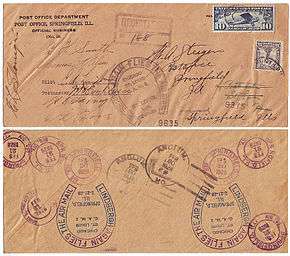
Lindbergh used his fame to promote air mail service. For example, at the request of the owner of West Indian Aerial Express (and later Pan Am's chief pilot), in February 1928 he carried some 3,000 pieces of special souvenir mail between Santo Domingo, R.D., Port-au-Prince, Haiti, and Havana, Cuba[95]—the last three stops he and the Spirit made during their 7,800 mi (12,600 km) "Good Will Tour" of Latin America and the Caribbean between December 13, 1927 and February 8, 1928.[96]
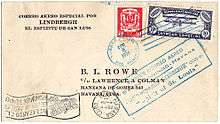
Two weeks after his Latin American tour, Lindbergh piloted a series of special flights over his old CAM-2 route on February 20 and February 21. Tens of thousands of self-addressed souvenir covers were sent in from all over the world, so at each stop Lindbergh switched to another of the three planes he and his fellow CAM-2 pilots had used, so it could be said that each cover had been flown by him. The covers were then backstamped and returned to their senders as promotion of the Air Mail Service.[97]
In 1929–1931, Lindbergh carried much smaller numbers of souvenir covers on the first flights over routes in Latin America and the Caribbean, which he had earlier laid out as a consultant to Pan American Airways to be then flown under contract to the Post Office as Foreign Air Mail (FAM) routes 5 and 6.[98]
Personal life
American family
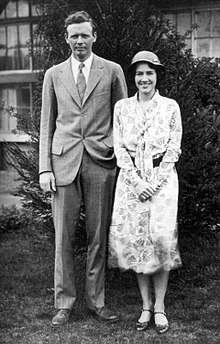
In his autobiography, Lindbergh derided pilots he met as womanizing "barnstormers"; he also criticized Army cadets for their "facile" approach to relationships. He wrote that the ideal romance was stable and long-term, with a woman with keen intellect, good health, and strong genes,[99] his "experience in breeding animals on our farm [having taught him] the importance of good heredity".[100]
Anne Morrow Lindbergh (1906–2001) was the daughter of Dwight Morrow who, as partner at J.P. Morgan & Co., had acted as financial adviser to Lindbergh. He was also the U.S. Ambassador to Mexico in 1927. Invited by Morrow on a goodwill tour to Mexico, Lindbergh met Anne in Mexico City in December 1927.[101]
The couple was married on May 27, 1929 in Englewood, New Jersey.[102] They had six children: Charles Augustus Lindbergh Jr. (1930–1932); Jon Morrow Lindbergh (b. 1932); Land Morrow Lindbergh (b. 1937), who studied anthropology at Stanford University and married Susan Miller in San Diego;[103] Anne Lindbergh (1940–1993); Scott Lindbergh (b. 1942); and Reeve Lindbergh (b. 1945), a writer. Lindbergh taught Anne how to fly and she accompanied and assisted him in much of his exploring and charting of air routes.
Lindbergh saw his children for only a few months a year. He kept track of each child's infractions (including such things as gum-chewing) and insisted that Anne track every penny of household expenses in account books.[104]
Kidnapping of Charles Lindbergh Jr.
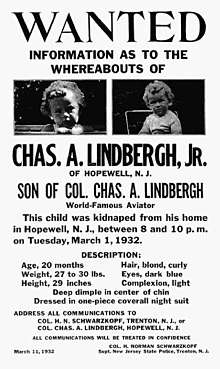
On the evening of March 1, 1932, twenty-month-old(1 year 8 months) Charles Augustus Lindbergh Jr. was abducted from his crib in the Lindbergh's rural home, Highfields, in East Amwell, New Jersey, near the town of Hopewell.[N 4] A man who claimed to be the kidnapper[106] picked up a cash ransom of $50,000 on April 2, part of which was in gold certificates, which were soon to be withdrawn from circulation and would therefore attract attention; the bills' serial numbers were also recorded. On May 12, the child's remains were found in woods not far from the Lindbergh home.[107]
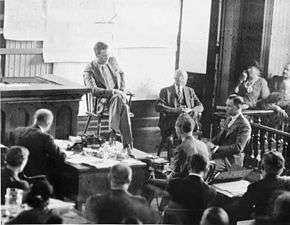
The case was widely called "The Crime of the Century" and was described by H. L. Mencken as "the biggest story since the Resurrection".[108] In response, Congress passed the so-called "Lindbergh Law", which made kidnapping a federal offense if the victim is taken across state lines or (as in the Lindbergh case) the kidnapper uses "the mail or ... interstate or foreign commerce in committing or in furtherance of the commission of the offense", such as in demanding ransom.[109]
Richard Hauptmann, a 34-year-old German immigrant carpenter, was arrested near his home in the Bronx, New York, on September 19, 1934, after paying for gasoline with one of the ransom bills. $13,760 of the ransom money and other evidence was found in his home. Hauptmann went on trial for kidnapping, murder and extortion on January 2, 1935 in a circus-like atmosphere in Flemington, New Jersey. He was convicted on February 13,[110] sentenced to death, and electrocuted at Trenton State Prison on April 3, 1936.[111]
In Europe (1936–1939)
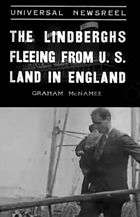
An intensely private man,[112] Lindbergh became exasperated by the unrelenting public attention in the wake of the kidnapping and Hauptmann trial,[113][114] and was concerned for the safety of his three-year-old second son, Jon.[115][116] Consequently, in the predawn hours of Sunday, December 22, 1935, the family "sailed furtively"[113] from Manhattan for Liverpool,[117] the only three passengers aboard the United States Lines freighter SS American Importer.[N 5] They traveled under assumed names and with diplomatic passports issued through the personal intervention of Treasury Secretary Ogden L. Mills.[119]
News of the Lindberghs' "flight to Europe"[113] did not become public until a full day later,[120][121] and even after the identity of their ship became known[114] radiograms addressed to Lindbergh on it were returned as "Addressee not aboard".[113] They arrived in Liverpool on December 31, then departed for South Wales to stay with relatives.[122][123]
The family eventually rented "Long Barn" in Sevenoaks Weald, Kent.[124] In 1938, the family moved to Île Illiec, a small four-acre island Lindbergh purchased off the Breton coast of France.[125]
Except for a brief visit to the U.S. in December 1937,[126] the family (including a third son, Land, born May 1937 in London) lived and traveled extensively in Europe before returning to the U.S. in April 1939, settling in a rented seaside estate at Lloyd Neck, Long Island, New York.[127][128] The return was prompted by a personal request by General H. H. ("Hap") Arnold, the chief of the United States Army Air Corps in which Lindbergh was a reserve colonel, for him to accept a temporary return to active duty to help evaluate the Air Corp's readiness for war.[129][130] His duties included evaluating new aircraft types in development, recruitment procedures, and finding a site for a new air force research institute and other potential air bases.[131] Assigned a Curtiss P-36 fighter, he toured various facilities, reporting back to Wright Field.[131] Lindbergh's brief four-month tour was also his first period of active military service since his graduation from the Army's Flight School fourteen years earlier in 1925.[127]
Scientific activities
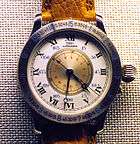
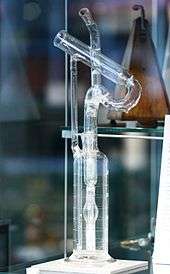
Lindbergh wrote to the Longines watch company and described a watch that would make navigation easier for pilots. First produced in 1931,[132] it is still produced today.[133]
In 1929, Lindbergh became interested in the work of rocket pioneer Robert H. Goddard. By helping Goddard secure an endowment from Daniel Guggenheim in 1930, Lindbergh allowed Goddard to expand his research and development. Throughout his life, Lindbergh remained a key advocate of Goddard's work.[134]
In 1930, Lindbergh's sister-in-law developed a fatal heart condition.[135] Lindbergh began to wonder why hearts could not be repaired with surgery. Starting in early 1931 at the Rockefeller Institute and continuing during his time living in France, Lindbergh studied the perfusion of organs outside the body with Nobel Prize-winning French surgeon Alexis Carrel. Although perfused organs were said to have survived surprisingly well, all showed progressive degenerative changes within a few days.[136] Lindbergh's invention, a glass perfusion pump, named the "Model T" pump, is credited with making future heart surgeries possible. In this early stage, the pump was far from perfected. In 1938, Lindbergh and Carrel described an artificial heart in the book in which they summarized their work, The Culture of Organs,[137] but it was decades before one was built. In later years, Lindbergh's pump was further developed by others, eventually leading to the construction of the first heart-lung machine.[138]
Pre-war activities and politics
Overseas visits
At the request of the United States military, Lindbergh traveled to Germany several times between 1936 and 1938 to evaluate German aviation.[139] Hanna Reitsch demonstrated the Focke-Wulf Fw 61 helicopter to Lindbergh in 1937,[140]:121 and he was the first American to examine Germany's newest bomber, the Junkers Ju 88, and Germany's front-line fighter aircraft, the Messerschmitt Bf 109, which he was allowed to pilot. He said of the Bf 109 that he knew of "no other pursuit plane which combines simplicity of construction with such excellent performance characteristics".[139][141] There is disagreement on how accurate Lindbergh's reports were, but Cole asserts that the consensus among British and American officials was that they were slightly exaggerated but badly needed.[142] Arthur Krock, the Chief of The New York Times's Washington Bureau, wrote in 1939, "When the new flying fleet of the United States begins to take air, among those who will have been responsible for its size, its modernness, and its efficiency is Colonel Charles A. Lindbergh. Informed officials here, in touch with what Colonel Lindbergh has been doing for his country abroad, are authority for this statement, and for the further observation that criticism of any of his activities - in Germany or elsewhere - is as ignorant as it is unfair."[143] General Henry H. Arnold, the only U.S. Air Force general to hold five-star rank, wrote in his autobiography, "Nobody gave us much useful information about Hitler's air force until Lindbergh came home in 1939."[144] Lindbergh also undertook a survey of aviation in the Soviet Union in 1938.[145]
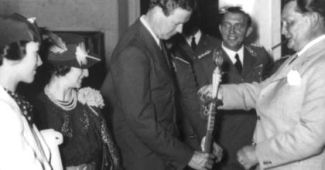
In 1938, Hugh Wilson, the American ambassador to Germany, hosted a dinner for Lindbergh with Germany's air chief, Generalfeldmarschall Hermann Göring, and three central figures in German aviation: Ernst Heinkel, Adolf Baeumker, and Willy Messerschmitt.[146] At this dinner, Generalfeldmarschall Göring (later promoted to Reichsmarschall, in July 1940) presented Lindbergh with the Commander Cross of the Order of the German Eagle. Lindbergh's acceptance proved controversial after Kristallnacht, an anti-Jewish pogrom in Germany a few weeks later.[147] Lindbergh declined to return the medal, later writing, "It seems to me that the returning of decorations, which were given in times of peace and as a gesture of friendship, can have no constructive effect. If I were to return the German medal, it seems to me that it would be an unnecessary insult. Even if war develops between us, I can see no gain in indulging in a spitting contest before that war begins."[148] Regarding this, Ambassador Wilson later wrote to Lindbergh, "Neither you, nor I, nor any other American present had any previous hint that the presentation would be made. I have always felt that if you refused the decoration, presented under those circumstances, you would have been guilty of a breach of good taste. It would have been an act offensive to a guest of the Ambassador of your country, in the house of the Ambassador."[143]
Non-interventionism and America First involvement
At the urging of U.S. Ambassador Joseph Kennedy, Lindbergh wrote a secret memo to the British warning that a military response by Britain and France to Hitler's violation of the Munich Agreement would be disastrous; he claimed that France was militarily weak and Britain over-reliant on its navy. He urgently recommended that they strengthen their air power to force Hitler to redirect his aggression against "Asiatic Communism".[142]
Following Hitler's invasion of Czechoslovakia and Poland, Lindbergh opposed sending aid to countries under threat, writing "I do not believe that repealing the arms embargo would assist democracy in Europe" and[149] "If we repeal the arms embargo with the idea of assisting one of the warring sides to overcome the other, then why mislead ourselves by talk of neutrality?"[149] He equated assistance with war profiteering: "To those who argue that we could make a profit and build up our own industry by selling munitions abroad, I reply that we in America have not yet reached a point where we wish to capitalize on the destruction and death of war."[149]
In August 1939, Lindbergh was the first choice of Albert Einstein, whom he met years earlier in New York, to deliver the Einstein–Szilárd letter alerting President Roosevelt about the vast potential of nuclear fission. However, Lindbergh did not respond to Einstein's letter or to Szilard's later letter of September 13. Two days later, Lindbergh gave a nationwide radio address, in which he called for isolationism and indicated some pro-German sympathies and antisemitic insinuations about Jewish ownership of the media, "We must ask who owns and influences the newspaper, the news picture, and the radio station, ... If our people know the truth, our country is not likely to enter the war". After that, Szilard stated to Einstein: "Lindbergh is not our man."[150]:475
In October 1939, following the outbreak of hostilities between Britain and Germany, and a month after the Canadian declaration of war on Germany, Lindbergh made another nationwide radio address criticizing Canada for drawing the Western Hemisphere "into a European war simply because they prefer the Crown of England" to the independence of the Americas.[151][152] Lindbergh went on to further state his opinion that the entire continent and its surrounding islands needed to be free from the "dictates of European powers".[151][152]
In November 1939, Lindbergh authored a controversial Reader's Digest article in which he deplored the war, but asserted the need for a German assault on Russia.[142] Lindbergh wrote: "Our civilization depends on peace among Western nations ... and therefore on united strength, for Peace is a virgin who dare not show her face without Strength, her father, for protection."[153][154]
In late 1940 Lindbergh became spokesman of the non-interventionist America First Committee,[155] soon speaking to overflow crowds at Madison Square Garden and Chicago's Soldier Field, with millions listening by radio. He argued emphatically that America had no business attacking Germany. Lindbergh justified this stance in writings that were only published posthumously:
I was deeply concerned that the potentially gigantic power of America, guided by uninformed and impractical idealism, might crusade into Europe to destroy Hitler without realizing that Hitler's destruction would lay Europe open to the rape, loot and barbarism of Soviet Russia's forces, causing possibly the fatal wounding of Western civilization.[156]
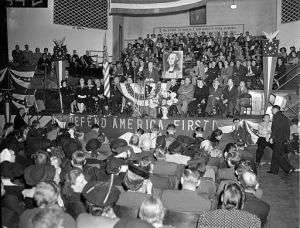
In April of 1941, argued before 30,000 members of the America First Committee that "the British government has one last desperate plan... to persuade us to send another American Expeditionary Force to Europe and to share with England militarily, as well as financially, the fiasco of this war."[157]
In his 1941 testimony before the House Committee on Foreign Affairs opposing the Lend-Lease bill, Lindbergh proposed that the United States negotiate a neutrality pact with Germany.[158] President Franklin Roosevelt publicly decried Lindbergh's views as those of a "defeatist and appeaser", comparing him to U.S. Rep. Clement L. Vallandigham, who had led the "Copperhead" movement opposed to the American Civil War. Lindbergh promptly resigned his commission as a colonel in the U.S. Army Air Corps, writing that he saw "no honorable alternative" given that Roosevelt had publicly questioned his loyalty.[159]
At an America First rally in September, Lindbergh accused three groups of "pressing this country toward war; the British, the Jewish, and the Roosevelt Administration":[160]
It is not difficult to understand why Jewish people desire the overthrow of Nazi Germany. The persecution they suffered in Germany would be sufficient to make bitter enemies of any race.
No person with a sense of the dignity of mankind can condone the persecution of the Jewish race in Germany. But no person of honesty and vision can look on their pro-war policy here today without seeing the dangers involved in such a policy both for us and for them. Instead of agitating for war, the Jewish groups in this country should be opposing it in every possible way for they will be among the first to feel its consequences.
Tolerance is a virtue that depends upon peace and strength. History shows that it cannot survive war and devastations. A few far-sighted Jewish people realize this and stand opposed to intervention. But the majority still do not.
Their greatest danger to this country lies in their large ownership and influence in our motion pictures, our press, our radio and our government.
He continued:
I am not attacking either the Jewish or the British people. Both races, I admire. But I am saying that the leaders of both the British and the Jewish races, for reasons which are as understandable from their viewpoint as they are inadvisable from ours, for reasons which are not American, wish to involve us in the war. We cannot blame them for looking out for what they believe to be their own interests, but we also must look out for ours. We cannot allow the natural passions and prejudices of other peoples to lead our country to destruction.[162]
His message was popular throughout many Northern communities and especially well received in the Midwest, while the American South was anglophilic and supported a pro-British foreign policy.[163] The South was the most pro-British and interventionist part of the country.[164] Responding to criticism of his speech,[165] Lindbergh denied he was antisemitic but did not back away from his positions.
Anne Lindbergh felt that the speech might tarnish Lindbergh's reputation unjustly; she wrote in her diary:
I have the greatest faith in [Lindbergh] as a person—in his integrity, his courage, and his essential goodness, fairness, and kindness—his nobility really ... How then explain my profound feeling of grief about what he is doing? If what he said is the truth (and I am inclined to think it is), why was it wrong to state it? He was naming the groups that were pro-war. No one minds his naming the British or the Administration. But to name "Jew" is un-American—even if it is done without hate or even criticism. Why?[166]
Lindbergh's reaction to Kristallnacht was entrusted to his diary: "I do not understand these riots on the part of the Germans," he wrote. "It seems so contrary to their sense of order and intelligence. They have undoubtedly had a difficult 'Jewish problem', but why is it necessary to handle it so unreasonably?"[167] Lindbergh had planned to move to Berlin for the winter of 1938–39. He had provisionally found a house in Wannsee, but after Nazi friends discouraged him from leasing it because it had been formerly owned by Jews,[168] it was recommended that he contact Albert Speer, who said he would build the Lindberghs a house anywhere they wanted. On the advice of his close friend Alexis Carrel, he cancelled the trip.[168]
In his diaries, he wrote, "We must limit to a reasonable amount the Jewish influence ... Whenever the Jewish percentage of total population becomes too high, a reaction seems to invariably occur. It is too bad because a few Jews of the right type are, I believe, an asset to any country."
Alleged Nazi sympathies
Lindbergh's anticommunism resonated deeply with many Americans, while his eugenics and Nordicism enjoyed social acceptance.[154] His speeches and writings reflected his adoption of views on race, religion, and eugenics, similar to those of the Nazis, and he was suspected of being a Nazi sympathizer.[169][170] However - as reported above - during a speech in September 1941, Lindbergh stated "no person with a sense of the dignity of mankind can condone the persecution of the Jewish race in Germany."[171] Interventionist pamphlets pointed out that his efforts were praised in Nazi Germany and included quotations such as "Racial strength is vital; politics, a luxury".[172]
Roosevelt disliked Lindbergh's outspoken opposition to his administration's interventionist policies, telling Treasury Secretary Henry Morgenthau, "If I should die tomorrow, I want you to know this, I am absolutely convinced Lindbergh is a Nazi."[173] In 1941 he wrote to Secretary of War Henry Stimson: "When I read Lindbergh's speech I felt that it could not have been better put if it had been written by Goebbels himself. What a pity that this youngster has completely abandoned his belief in our form of government and has accepted Nazi methods because apparently they are efficient."[174] Shortly after the war ended, Lindbergh toured a Nazi concentration camp, and wrote in his diary, "Here was a place where men and life and death had reached the lowest form of degradation. How could any reward in national progress even faintly justify the establishment and operation of such a place?"[171]
Attitudes toward race
He seemed to state that he believed the survival of the white race was more important than the survival of democracy in Europe: "Our bond with Europe is one of race and not of political ideology," he declared.[175] Critics have noticed an apparent influence on Lindbergh of German philosopher Oswald Spengler.[176] Spengler was a conservative authoritarian popular during the interwar period, though he had fallen out of favor with the Nazis because he had not wholly subscribed to their theories of racial purity.[176]
Lindbergh developed a long-term friendship with the automobile pioneer Henry Ford, who was well known for his antisemitic newspaper The Dearborn Independent. In a famous comment about Lindbergh to Detroit's former FBI field office special agent in charge in July 1940, Ford said: "When Charles comes out here, we only talk about the Jews."[177][178]
Lindbergh considered Russia a "semi-Asiatic" country compared to Germany, and he believed Communism was an ideology that would destroy the West's "racial strength" and replace everyone of European descent with "a pressing sea of Yellow, Black, and Brown". He stated that if he had to choose, he would rather see America allied with Nazi Germany than Soviet Russia. He preferred Nordics, but he believed, after Soviet Communism was defeated, Russia would be a valuable ally against potential aggression from East Asia.[176][179]
Lindbergh elucidated his beliefs regarding the white race in a 1939 article in Reader's Digest:
We can have peace and security only so long as we band together to preserve that most priceless possession, our inheritance of European blood, only so long as we guard ourselves against attack by foreign armies and dilution by foreign races.[180]
Lindbergh said certain races have "demonstrated superior ability in the design, manufacture, and operation of machines".[181] He further said, "The growth of our western civilization has been closely related to this superiority."[182] Lindbergh admired "the German genius for science and organization, the English genius for government and commerce, the French genius for living and the understanding of life". He believed, "in America they can be blended to form the greatest genius of all."[183]
In his book The American Axis, Holocaust researcher and investigative journalist Max Wallace agreed with Franklin Roosevelt's assessment that Lindbergh was "pro-Nazi". However, he found that the Roosevelt Administration's accusations of dual loyalty or treason were unsubstantiated. Wallace considered Lindbergh to be a well-intentioned but bigoted and misguided Nazi sympathizer whose career as the leader of the isolationist movement had a destructive impact on Jewish people.[184]
Lindbergh's Pulitzer Prize-winning biographer, A. Scott Berg, contended that Lindbergh was not so much a supporter of the Nazi regime as someone so stubborn in his convictions and relatively inexperienced in political maneuvering that he easily allowed rivals to portray him as one. Lindbergh's receipt of the German medal, presented by Generalfeldmarschall Hermann Göring on behalf of Führer Adolf Hitler, was approved without objection by the American embassy; the war had not yet begun in Europe. The award did not cause controversy until the war began and Lindbergh returned to the United States in 1939 to spread his message of nonintervention. Berg contended Lindbergh's views were commonplace in the United States in the pre–World War II era. Lindbergh's support for the America First Committee was representative of the sentiments of a number of American people.[185]
Berg also noted: "As late as April 1939—after Germany overtook Czechoslovakia—Lindbergh was willing to make excuses for Hitler. 'Much as I disapprove of many things Hitler had done,' he wrote in his diary on April 2, 1939, 'I believe she [Germany] has pursued the only consistent policy in Europe in recent years. I cannot support her broken promises, but she has only moved a little faster than other nations ... in breaking promises. The question of right and wrong is one thing by law and another thing by history.'" Berg also explained that leading up to the war, Lindbergh believed the great battle would be between the Soviet Union and Germany, not fascism and democracy.
Wallace noted that it was difficult to find social scientists among Lindbergh's contemporaries in the 1930s who found validity in racial explanations for human behavior. Wallace went on to observe, "throughout his life, eugenics would remain one of Lindbergh's enduring passions."[186]
Lindbergh always championed military strength and alertness.[187][188] He believed that a strong defensive war machine would make America an impenetrable fortress and defend the Western Hemisphere from an attack by foreign powers, and that this was the U.S. military's sole purpose.[189]
Berg writes that while the attack on Pearl Harbor came as a shock to Lindbergh, he did predict that America's "wavering policy in the Philippines" would invite a brutal war there, and in one speech warned, "we should either fortify these islands adequately, or get out of them entirely."[190]
World War II
After the Japanese attack on Pearl Harbor, Lindbergh sought to be recommissioned in the USAAF. The Secretary of War, Henry L. Stimson, declined the request on instructions from the White House.[191]
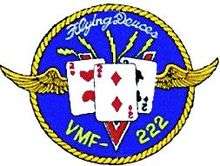
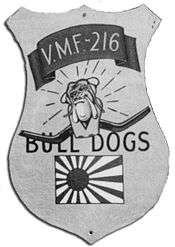
Unable to take on an active military service, Lindbergh approached a number of aviation companies and offered his services as a consultant. As a technical adviser with Ford in 1942, he was heavily involved in troubleshooting early problems at the Willow Run Consolidated B-24 Liberator bomber production line. As B-24 production smoothed out, he joined United Aircraft in 1943 as an engineering consultant, devoting most of his time to its Chance-Vought Division.[192]
The following year, Lindbergh persuaded United Aircraft to send him as a technical representative to the Pacific Theater to study aircraft performance under combat conditions. He demonstrated how Marine pilots could take off safely with a bomb load double the Vought F4U Corsair fighter-bomber's rated capacity. At the time, several Marine squadrons were flying bomber escorts to destroy the Japanese stronghold of Rabaul, New Britain, in the Australian Territory of New Guinea. On May 21, 1944, Lindbergh flew his first combat mission: a strafing run with VMF-222 near the Japanese garrison of Rabaul.[193] He also flew with VMF-216, from the Marine Air Base at Torokina, Bougainville. Lindbergh was escorted on one of these missions by Lt. Robert E. (Lefty) McDonough, who refused to fly with Lindbergh again, as he did not want to be known as "the guy who killed Lindbergh".[193]
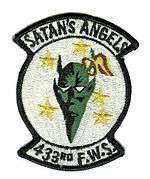
In his six months in the Pacific in 1944, Lindbergh took part in fighter bomber raids on Japanese positions, flying 50 combat missions (again as a civilian).[194] His innovations in the use of Lockheed P-38 Lightning fighters impressed a supportive Gen. Douglas MacArthur.[195] Lindbergh introduced engine-leaning techniques to P-38 pilots, greatly improving fuel consumption at cruise speeds, enabling the long-range fighter aircraft to fly longer range missions. P-38 pilot Warren Lewis quoted Lindbergh's fuel saving settings, "He said, '...we can cut the RPM down to 1400RPMs and use 30 inches of mercury (manifold pressure), and save 50 - 100 gallons of fuel on a mission.'"[196] The U.S. Marine and Army Air Force pilots who served with Lindbergh praised his courage and defended his patriotism.[193][197]
On July 28, 1944, during a P-38 bomber escort mission with the 433rd Fighter Squadron in the Ceram area, Lindbergh shot down a Mitsubishi Ki-51 "Sonia" observation plane, piloted by Captain Saburo Shimada, commanding officer of the 73rd Independent Chutai.[193][198]
Lindbergh's participation in combat was revealed in a story in the Passaic Herald-News on October 22, 1944.[199]
In mid-October 1944, Lindbergh participated in a joint Army-Navy conference on fighter planes at NAS Patuxent River, Maryland.[200]
After the war, Lindbergh toured the Nazi concentration camps and wrote in his autobiography that he was disgusted and angered.[N 6]
Later life
After World War II, Lindbergh lived in Darien, Connecticut, and served as a consultant to the Chief of Staff of the United States Air Force and to Pan American World Airways. With most of eastern Europe under Communist control, Lindbergh believed that his prewar assessments of the Soviet threat were correct. Lindbergh witnessed firsthand the defeat of Germany and the Holocaust, and Berg reported, "he knew the American public no longer gave a hoot about his opinions." In 1954, on the recommendation of President Dwight D. Eisenhower, Lindbergh was commissioned a brigadier general in the U.S. Air Force Reserve. Also in that year, he served on a Congressional advisory panel that recommended the site of the United States Air Force Academy.
In December 1968, he visited the crew of Apollo 8 (the first manned mission to orbit the Moon) the day before their launch, and in 1969 he watched the launch of Apollo 11.[202] In conjunction with the first lunar landing, he shared his thoughts as part of Walter Cronkite's live television coverage. He later wrote the foreword to Apollo astronaut Michael Collins's autobiography.[203]
Double life and secret German children
Beginning in 1957, Brigadier General Lindbergh had engaged in lengthy sexual relationships with three women while he remained married to Anne Morrow. He fathered three children with hatmaker Brigitte Hesshaimer (1926–2001), who had lived in the small Bavarian town of Geretsried. He had two children with her sister Mariette, a painter, living in Grimisuat. Lindbergh also had a son and daughter (born in 1959 and 1961) with Valeska, an East Prussian aristocrat who was his private secretary in Europe and lived in Baden-Baden.[204][205][206][207] All seven children were born between 1958 and 1967.[208]
Ten days before he died, Lindbergh wrote to each of his European mistresses, imploring them to maintain the utmost secrecy about his illicit activities with them even after his death.[209] The three women (none of whom ever married) all managed to keep their affairs secret even from their children, who during his lifetime (and for almost a decade after his death) did not know the true identity of their father, whom they had only known by the alias Careu Kent and they had seen him only when he briefly visited them once or twice a year. However, after reading a magazine article about Lindbergh in the mid-1980s, Brigitte's daughter Astrid deduced the truth; she later discovered snapshots and more than 150 love letters from Lindbergh to her mother. After Brigitte and Anne Lindbergh had both died, she made her findings public; in 2003 DNA tests confirmed that Lindbergh had fathered Astrid and her two siblings.[208][210] Reeve Lindbergh, Lindbergh's youngest child with Anne, wrote in her personal journal in 2003, "This story reflects absolutely Byzantine layers of deception on the part of our shared father. These children did not even know who he was! He used a pseudonym with them (To protect them, perhaps? To protect himself, absolutely!)"[211]
Environmental causes
In later life Lindbergh was heavily involved in conservation movements, and was deeply concerned about the negative impacts of new technologies on the natural world and native peoples, in particular on Hawaii.[212][213] He campaigned to protect endangered species such as the humpback whale, blue whale,[213] Philippine eagle, the tamaraw (a rare dwarf Philippine buffalo), and was instrumental in establishing protections for the Tasaday people, and various African tribes such as the Maasai.[213] Alongside Laurance S. Rockefeller, Lindbergh helped establish the Haleakalā National Park in Hawaii.[214]
Lindbergh's speeches and writings in later life emphasized technology and nature, and his lifelong belief that "... all the achievements of mankind have value only to the extent that they preserve and improve the quality of life."[212]
Death
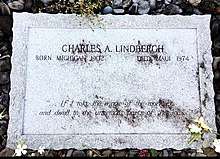
Lindbergh spent his last years on the Hawaiian island of Maui, where he died of lymphoma[215] on August 26, 1974, at age 72. He was buried on the grounds of the Palapala Ho'omau Church in Kipahulu, Maui. His epitaph, on a simple stone following the words "Charles A. Lindbergh Born Michigan 1902 Died Maui 1974", quotes Psalm 139:9: "... If I take the wings of the morning, and dwell in the uttermost parts of the sea ... C.A.L."[216]
Honors and tributes
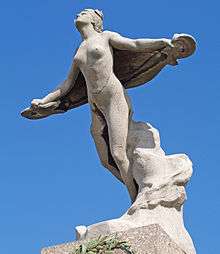
- Lindbergh was a recipient of the Silver Buffalo Award, the highest adult award given by the Boy Scouts of America, on April 10, 1928 in San Francisco.[217]
- On May 8, 1928 a statue was dedicated at the entrance to Le Bourget Airport in Paris honoring Lindbergh and his New York to Paris flight as well as Charles Nungesser and Francois Coli who had attempted the same feat two weeks earlier in the other direction aboard L'Oiseau Blanc (The White Bird), disappearing without a trace.
- Several U.S. airports have been named for Lindbergh.
- In 1933 the Lindbergh Range (Danish: Lindbergh Fjelde) in Greenland was named after him by Danish Arctic explorer Lauge Koch following aerial surveys made during the 1931–1934 Three-year Expedition to East Greenland.[218]
- In St. Louis County, Missouri a school district, high school and highway are named for Lindbergh, and he has a star on the St. Louis Walk of Fame.[219] Numerous schools are named after Lindbergh throughout the United States.
- In 1937 a transatlantic race was proposed to commemorate the tenth anniversary of Lindbergh's flight to Paris, though it was eventually modified to take a different course of similar length (see 1937 Istres–Damascus–Paris Air Race).
- He was inducted into the National Aviation Hall of Fame in 1967.
- The Royal Air Force Museum in England minted a medal with his image as part of a 50 medal set called The History of Man in Flight in 1972.[220]
- The original Lindbergh residence is maintained as a museum, and is listed as a National Historic Landmark.[221][222]
- In February 2002, the Medical University of South Carolina at Charleston, within the celebrations for the Lindbergh 100th birthday established the Lindbergh-Carrel Prize,[223] given to major contributors to "development of perfusion and bioreactor technologies for organ preservation and growth". M. E. DeBakey and nine other scientists[224] received the prize, a bronze statuette expressly created for the event by the Italian artist C. Zoli and named "Elisabeth", after Elisabeth Morrow, sister of Lindbergh's wife Anne Morrow, who died as a result of heart disease.[225] Lindbergh was disappointed that contemporary medical technology could not provide an artificial heart pump that would allow for heart surgery on Elisabeth and that led to the first contact between Carrel and Lindbergh.[225]
Awards and decorations
Lindbergh received many awards, medals and decorations, most of which were later donated to the Missouri Historical Society and are on display at the Jefferson Memorial, now part of the Missouri History Museum in Forest Park in St. Louis, Missouri.[226]
- United States government
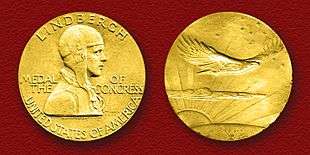


- Langley Gold Medal from the Smithsonian Institution (1927)
- Congressional Gold Medal (1928)
- other United States
- Orteig Prize (1927, see details above)
- Harmon Trophy (1927)
- Hubbard Medal (1927)
- Honorary Scout (Boy Scouts of America, 1927)[227]
- Silver Buffalo Award (Boy Scouts of America, 1928)[228]
- Wright Brothers Memorial Trophy (1949)
- Daniel Guggenheim Medal (1953)
- Pulitzer Prize (1954)
- Non-U.S. awards




- Fédération Aéronautique Internationale FAI Gold Medal (1927)
- ICAO Edward Warner Award (1975)[231]
- Royal Swedish Aero Clubs Gold plaque (1927)[232]
Medal of Honor
Rank and organization: Captain, U.S. Army Air Corps Reserve. Place and date: From New York City to Paris, France, May 20–21, 1927. Entered service at: Little Falls, Minn. Born: February 4, 1902, Detroit, Mich. G.O. No.: 5, W.D., 1928; Act of Congress December 14, 1927.[233][N 7]
- Citation
For displaying heroic courage and skill as a navigator, at the risk of his life, by his nonstop flight in his airplane, the "Spirit of St. Louis", from New York City to Paris, France, 20–21 May 1927, by which Capt. Lindbergh not only achieved the greatest individual triumph of any American citizen but demonstrated that travel across the ocean by aircraft was possible.[237]
Other recognition
- 1991 Scandinavian-American Hall of Fame Inductee[238]
- 1965 International Aerospace Hall of Fame Inductee[239]
- Ranked No. 3 on Flying magazine's 51 Heroes of Aviation[240]
- Member of the Independent Order of Odd Fellows[241]
Books
In addition to "WE" and The Spirit of St. Louis, Lindbergh wrote prolifically over the years on other topics, including science, technology, nationalism, war, materialism, and values. Included among those writings were five other books: The Culture of Organs (with Dr. Alexis Carrel) (1938), Of Flight and Life (1948), The Wartime Journals of Charles A. Lindbergh (1970), Boyhood on the Upper Mississippi (1972), and his unfinished Autobiography of Values (posthumous, 1978).[242][243]
In popular culture
Literature
In addition to many biographies such as A. Scott Berg's massive "Lindbergh" published in 1999 and others, Lindbergh also influenced or was the model for characters in a variety of works of fiction.[244] Shortly after he made his famous flight, the Stratemeyer Syndicate began publishing a series of books for juvenile readers called the Ted Scott Flying Stories (1927–1943), which were written by a number of authors all using the nom de plume of Franklin W. Dixon, in which the pilot hero was closely modeled after Lindbergh. Ted Scott duplicated the solo flight to Paris in the series' first volume, entitled Over the Ocean to Paris published in 1927.[245] Another fictional literary reference to Lindbergh appears in the Agatha Christie book (1934) and movie Murder on the Orient Express (1974) which begins with a fictionalized depiction of the Lindbergh kidnapping.[246]
In Daniel Easterman's K is for Killing (1997), a fictional Charles Lindbergh becomes President of a fascist United States. His vice-president, and power behind the throne, is the notorious rapist and Grand Dragon of the Ku Klux Klan, David Stephenson. Eventually, Lindbergh is assassinated in the novel and it is implied that Stephenson, who has now risen to President of the United States, orchestrated Lindbergh's murder.
The Philip Roth novel The Plot Against America (2004) explores an alternate history where Franklin Delano Roosevelt is defeated in the 1940 presidential election by Lindbergh, who allies the United States with Nazi Germany.[247]
Film and television
- The 1942 MGM picture Keeper of the Flame (Katharine Hepburn, Spencer Tracy) features Hepburn as the widow of Robert V. Forrest, a "Lindbergh-like" national hero.[248]
- In the motion picture The Spirit of St. Louis, directed by Billy Wilder and released in 1957, Lindbergh was played by James Stewart, an admirer of Lindbergh and himself an aviator who had flown bombing missions in World War II.[249] Stewart's performance as a man half his age was not well received, and the film was a commercial failure.[250]
- In 1976, Buzz Kulik's TV movie The Lindbergh Kidnapping Case, with Anthony Hopkins as Richard Bruno Hauptmann, premiered on NBC February 26.[251]
- Lindbergh has been the subject of numerous documentary films, including Charles A. Lindbergh (1927), a UK documentary by De Forest Phonofilm; 40,000 Miles with Lindbergh (1928) featuring Lindbergh himself; and The American Experience—Lindbergh: The Shocking, Turbulent Life of America's Lone Eagle (1988).[252][253][254]
Music
Within days of the flight, dozens of Tin Pan Alley publishers rushed a variety of popular songs into print celebrating Lindbergh and the Spirit of St. Louis including "Lindbergh (The Eagle of the U.S.A.)" by Howard Johnson and Al Sherman, and "Lucky Lindy" by L. Wolfe Gilbert and Abel Baer. In the two-year period following Lindbergh's flight, the U.S. Copyright Office recorded three hundred applications for Lindbergh songs.[255][256] Tony Randall revived "Lucky Lindy" in an album of Jazz Age and Depression-era songs that he recorded entitled Vo Vo De Oh Doe (1967).[257]
In 1929, Bertolt Brecht wrote a cantata called Der Lindberghflug (The Lindbergh Flight) with music by Kurt Weill and Paul Hindemith. Because of Lindbergh's apparent Nazi sympathies, in 1950 Brecht removed all direct references to Lindbergh and renamed the piece Der Ozeanflug (The Ocean Flight).[258]
Cartoons
During World War II, Lindbergh was a frequent target of Dr Seuss's first political cartoons, published in the New York magazine PM, in which Geisel emphasised Lindbergh's antiSemitism and Nazi sympathies.[259]
Postage stamps

Lindbergh and the Spirit have been honored by a variety of world postage stamps over the last eight decades, including three issued by the United States. Less than three weeks after the flight the U.S. Post Office Department issued a 10-cent "Lindbergh Air Mail" stamp (Scott C-10) on June 11, 1927, with engraved illustrations of both the Spirit of St. Louis and a map of its route from New York to Paris. This was also the first U.S. stamp to bear the name of a living person.[260] A half-century later, a 13-Cent commemorative stamp (Scott #1710) depicting the Spirit flying low over the Atlantic Ocean was issued on May 20, 1977, the 50th anniversary of the flight from Roosevelt Field.[261] On May 28, 1998, a 32¢ stamp with the legend "Lindbergh Flies Atlantic" (Scott #3184m) depicting Lindbergh and the "Spirit" was issued as part of the Celebrate the Century stamp sheet series.[262]
Other
St. Louis area-based GoJet Airlines uses the callsign "Lindbergh" after Charles Lindbergh.
See also
- Amelia Earhart
- Richard E. Byrd
- Bernt Balchen
- Clyde Pangborn
- Douglas Corrigan
- Howard Hughes
- Vikingsholm
- First aerial crossing of the South Atlantic
- List of firsts in aviation
- List of people on stamps of Ireland
- List of peace activists
- List of Medal of Honor recipients in non-combat incidents
- Third Man phenomenon
- Uncommon Friends of the 20th Century, a documentary about the friendship between Florida businessman James D. Newton and Charles
References
Notes
- Dates of military rank: Cadet, Army Air Corps – March 19, 1924, 2nd Lieutenant, Officer Reserve Corps (ORC) – March 14, 1925, 1st Lieutenant, ORC – December 7, 1925, Captain, ORC – July 13, 1926, Colonel, ORC – July 18, 1927 (As of 1927, Lindbergh was a member of the Missouri National Guard and was assigned to the 110th Observation Squadron in St. Louis.[28]), Brigadier General, USAFR – April 7, 1954.[29]
- "Always there was some new experience, always something interesting going on to make the time spent at Brooks and Kelly one of the banner years in a pilot's life. The training is difficult and rigid, but there is none better. A cadet must be willing to forget all other interest in life when he enters the Texas flying schools and he must enter with the intention of devoting every effort and all of the energy during the next 12 months towards a single goal. But when he receives the wings at Kelly a year later, he has the satisfaction of knowing that he has graduated from one of the world's finest flying schools." "WE" p. 125
- Cities in which Lindbergh and the Spirit of St. Louis landed during the Guggenheim Tour included: New York, N.Y.; Hartford, Conn.; Providence, R.I.; Boston, Mass.; Concord, N.H.; Orchard Beach & Portland, Me.; Springfield, Vt.; Albany, Schenectady, Syracuse, Rochester, & Buffalo, N.Y.; Cleveland, Ohio; Pittsburgh, Pa.; Wheeling, W.V.; Dayton & Cincinnati, Ohio; Louisville, Ky.; Indianapolis, Ind.; Detroit & Grand Rapids, Mich.; Chicago & Springfield, Ill.; St. Louis & Kansas City, Mo.; Wichita, Kan.; St. Joseph, Mo.; Moline, Ill.; Milwaukee & Madison, Wis.; Minneapolis/St. Paul & Little Falls, Minn.; Fargo, N.D.; Sioux Falls, S.D.; Des Moines, Iowa; Omaha, Neb.; Denver, Colo.; Pierre, S.D.; Cheyenne, Wyo.; Salt Lake City, Utah; Boise, Idaho; Butte & Helena, Mont.; Spokane & Seattle, Wash.; Portland, Ore.; San Francisco, Oakland, & Sacramento, Calif.; Reno, Nev.; Los Angeles & San Diego, Calif.; Tucson, Ariz.; Lordsburg, N.M.; El Paso, Texas; Santa Fe, N.M.; Abilene, Fort Worth & Dallas, Texas; Oklahoma City, Tulsa & Muskogee, Okla.; Little Rock, Ark.; Memphis & Chattanooga, Tenn.; Birmingham, Alabama; Jackson, Miss.; New Orleans, La.; Jacksonville, Fla.; Spartensburg, S.C.; Greensboro & Winston-Salen, N.C.; Richmond, Va.; Washington, D.C.; Baltimore, Md.; Atlantic City, N.J.; Wilmington, Del.; Philadelphia, Pa.; New York, N.Y.
- Quote: So while the world's attention was focused on Hopewell, from which the first press dispatches emanated about the kidnapping, the Democrat made sure its readers knew that the new home of Col. Charles A. Lindbergh and Anne Morrow Lindbergh was in East Amwell Township, Hunterdon County.[105]
- Lindbergh's "flight to Europe" ship SS American Importer was sold to Société Maritime Anversoise, Antwerp, Belgium in February, 1940 and renamed Ville de Gand. Just after midnight on August 19, 1940 the vessel was torpedoed by the German submarine U-48 about 200 miles west of Ireland while sailing from Liverpool to New York and sank with the loss of 14 crew.[118]
- In a stream of consciousness manner, Lindbergh detailed his visit immediately after World War II to a Nazi concentration camp, and his reactions. In the Japanese edition, there are no entries about Nazi camps. Instead, there is an entry recorded in his diary that he often witnessed atrocities against Japanese POWs by Australians and Americans.[201]
- In 1927 the Medal of Honor could still be awarded for extraordinarily heroic non-combat actions by active or reserve service members made during peacetime with almost all such medals being awarded to active duty members of the United States Navy for rescuing or attempting to rescue persons from drowning. In addition to Lindbergh, Floyd Bennett and Richard Evelyn Byrd of the Navy, were also presented with the medal for their accomplishments as explorers for their participation in the first successful heavier-than-air flight to the North Pole and back.[234][235][236]
Citations
- Every and Tracy 1927, pp. 60, 84, 99, 208.
- Bryson 2013, pp. 25–104.
- "Charles Lindbergh's Noninterventionist Efforts & America First Committee". www.charleslindbergh.com. Archived from the original on April 19, 2005. Retrieved February 3, 2006.
- "Charles Lindbergh's Sept 1 1941 Speech". www.historyonthenet.com. Archived from the original on June 21, 2019. Retrieved September 12, 2019.
- "Colonel Lindbergh On Combat Missions". The San Bernardino Daily Sun. 51. San Bernardino, California. Associated Press. October 23, 1944. p. 1.
- Larson 1973, pp. 31–32.
- Larson 1973, pp. 208–209.
- Duffy, James (2010). Lindbergh vs. Roosevelt. United States of America: MJF Books. pp. 5. ISBN 978-1-60671-130-9.
- Lindbergh 1927, pp. 19–22.
- Lindbergh 1927, pp. 22–25.
- Lindbergh 1927, p. 23.
- Lindbergh 1927, p. 25.
- Lindbergh 1927, pp. 26–28.
- Lindbergh 1927, pp. 29–36.
- Westover, Lee Ann. "Montana Aviator: Great Grandfather Bob Westover and Charles Lindbergh in Montana". Archived April 15, 2008, at the Wayback Machine The Iron Mullett, 2008. Retrieved: February 15, 2010.
- Lindbergh 1927, pp. 36–37.
- Lindbergh 1927, pp. 39–43.
- "Charles Lindbergh's First Solo Flight & First Plane" Archived May 4, 2008, at the Wayback Machine. Charles Lindbergh official site. Retrieved: February 15, 2010.
- Lindbergh 1927, pp. 43–44.
- Lindbergh 1927, pp. 44–45.
- "Daredevil Lindbergh and His Barnstorming Days" Archived March 14, 2017, at the Wayback Machine American Experience, PBS (WGBH), 1999.
- Lindbergh 1927, pp. 63–65.
- Smith, Susan Lampert "Dr. Bertha Stories: Dr. Bertha's Decades in the River Valley Included remarkable Medical Feats". Wisconsin State Journal, April 20, 2003.
- Lindbergh 1927, pp. 84–93.
- Berg 1998, p. 73.
- Lindbergh 1927, pp. 144–148.
- Moseley 1976, p. 56.
- Official National Guard Register. 1927. p. 529.
- Berg 1998, p. 488.
- "Charles Lindbergh: An American Aviator" Archived April 12, 2008, at the Wayback Machine. charleslindbergh.com. Retrieved: February 15, 2010.
- "Robertson Aircraft Corporation" Archived May 4, 2008, at the Wayback Machine. charleslindbergh.com.
- Berg 1995, p. 95. Archived February 22, 2014, at the Wayback Machine
- "Certificate of the Oath of Mail Messengers executed by Charles A. Lindbergh, Pilot, CAM-2, April 13, 1926" Archived May 27, 2008, at the Wayback Machine. charleslindbergh.com.
- Lindbergh 1927, pp. 185–7, 192–3
- Lindbergh 1953, pp. 6–8.
- Lindbergh 1927, pp. 185–193
- Lindbergh 1953, p. 79.
- "Alcock and Brown: The First Non-stop Aerial Crossing of the Atlantic" Archived December 13, 2010, at the Wayback Machine. The Aviation History Online Museum. Retrieved: July 17, 2009.
- Lindbergh 1953, pp. 31, 74.
- "Fate of Nungesser Still a Mystery". The New York Times, May 17, 1927, p. 3.
- dollartimes.com Archived September 27, 2017, at the Wayback Machine Retrieved July 3, 2017
- Lindbergh 1953, pp. 25, 31.
- "Air Race to Paris promised by backer of Bellanca plane" The New York Times, April 16, 1927 p. 1
- "Mail flyer chosen for Bellanca hop" The New York Times, April 20, 1927 p. 11
- "Acosta withdraws from Paris Flight" The New York Times, April 29, 1927 p. 23
- Lindbergh 1953, pp. 85–86.
- Hall, Nova "Spirit & Creator: The Mysterious Man Behind Lindbergh's Flight to Paris". Sheffield, MA:ATN Publishing (2002) p. 68
- Lindbergh 1953, pp. 134.
- "Archived copy". Archived from the original on August 12, 2019. Retrieved August 25, 2019.CS1 maint: archived copy as title (link)
- AP Archive (July 24, 2015). "First Pictures Of Lindbergh As He Reaches Paris In Flight From New York". Archived from the original on November 10, 2019. Retrieved December 22, 2017 – via YouTube.
- Lindbergh 1927, p. 216.
- https://www.airspacemag.com/history-of-flight/even-lindbergh-got-lost-3381643/ Archived November 13, 2017, at the Wayback Machine Retrieved January 24, 2018
- https://www.hodinkee.com/articles/the-history-and-science-behind-the-lindbergh-longines-hour-angle-watch/ Archived January 27, 2018, at the Wayback Machine More on the navigational issues and one of his post-flight attempts to reduce them. Retrieved January 24, 2018
- "Charles Lindbergh's Spirit of St. Louis flight log book entry, May 20, 1927". Archived from the original on December 7, 2017. Retrieved December 23, 2017.
- Lindbergh 1927, pp. 218–222.
- Bryson, Bill, "The Redeeming Spirit of Sr. Louis", The Sunday Times, September 15, 2013, News Review. p. 2. (from:, Bryson. B. One Summer: America 1927, 2013, New York, Doubleday.
- Lindbergh 1927, pp. 224–226.
- "Certification of Charles Lindbergh's flight required several documents to prove the performance" in "Lindbergh Flies the Atlantic, 1927". Archived May 27, 2013, at the Wayback Machine CharlesLindbergh.com, 2007. Retrieved: January 27, 2013.
- The Milwaukee Sentinel – June 23, 1929
- "Lindbergh given check by Orteig" Archived September 29, 2015, at the Wayback Machine. The Gettysburg Times (Associated Press), June 17, 1927, p. 2. Retrieved: January 8, 2016.
- A. Scott Berg, as cited in Belfiore 2007, p. 17.
- James, Edwin L. (May 22, 1927). "Lindbergh Does It! To Paris in 33 1/2 Hours; Flies 1,000 Miles Through Snow and Sleet; Cheering French Carry Him Off Field". The New York Times. p. 1. Archived from the original on January 12, 2019. Retrieved April 19, 2019.
- "Pages-From-Our-Past-Charles-Lindbergh-1927.jpg (800x1070 pixels)". June 4, 2014. Archived from the original on June 4, 2014.
- Costigliola 1984, p. 180.
- Bryson 2013, p. 101.
- Mosley 1976, p. 117.
- Lindbergh 1927, pp. 267–268.
- Mears, Medal of Honor, 90-91
- "Executive Order 4601--Distinguished Flying Cross". Archived from the original on October 15, 2012. Retrieved April 8, 2019.
- Shah, Sharad J. "In Celebration of Charles Lindbergh and his Transatlantic Flight". Smithsonian Unbound. Archived from the original on June 8, 2020. Retrieved June 8, 2020.
- MyFootage.com (June 23, 2011). "Stock Footage - CHARLES LINDBERGH. 1927. CROWDS. PARADE. TICKERTAPE. POLICE / NYC CELEBRATE". Archived from the original on March 9, 2020. Retrieved December 21, 2017 – via YouTube.
- Rae, Bruce "4,000,000 Hail Air Hero; Enthralled by His Daring Deed, City Cheers From Depths of Its Heart. Miles of Streets Jammed; Boyish Conqueror Honored at City Hall and Again by the Crowd in Central Park. Progress a Vast Ovation; Glittering Military Display and Gayly Decked Buildings Are Enhanced by Ideal Weather". The New York Times, June 14, 1927, p. 1.
- "Lindbergh Parade Has 10,000 Troops; Soldiers, Sailors and Marines Precede Flier From Battery to Central Park". The New York Times, June 14, 1927, p. 4.
- "Radio Keeps Pace with Lindbergh; Announcers Along Route Tell of His Progress, Noise Drowning Their Voices at Times. Every Detail Is Covered; 15,000,000 Are Thus Able to Take Part in Welcome and Escape Milling Crowds." The New York Times, June 14, 1927, p. 16.
- Bill Bryson, "One Summer: America, 1927" (Doubleday 1913)
- "Cheers of 3,700 Acclaim Lindbergh as City Gives Great Dinner for Him". The New York Times, June 15, 1927, p. 1.
- National Guard Register, 1928. p. 529.
- "Charles Lindbergh Medal of Honor" Archived August 11, 2007, at the Wayback Machine. charleslindbergh.com, 2014. Retrieved: January 8, 2016.
- New York Times. March 22, 1928.
- Mears, Medal of Honor, 91
- Mears, Medal of Honor, 138
- Mears, Medal of Honor, 144
- Alexander, Saffron (December 19, 2015). "Charles Lindbergh to Angela Merkel: TIME's Person of the Year through the ages". The Telegraph. Archived from the original on September 17, 2017. Retrieved September 14, 2017.
Aged just 25 at the time, Lindbergh remains the youngest person to ever be awarded the title of 'Man of the Year'.
- Jennings and Brewster 1998, p. 420.
- Herrmann, Anne "On Amelia Earhart: The Aviatrix as American Dandy" Archived September 21, 2016, at the Wayback Machine Ann Arnbor, MI:The Michigan Quarterly Review Volume XXXIX, Issue 1, Winter 2000
- Wohl, Robert. The Spectacle of Flight: Aviation and the Western Imagination, 1920–1950. New Haven, Connecticut: Yale University Press, 2005. ISBN 0-300-10692-0 p. 35.
- Lindbergh, Charles A. "WE" (with an appendix entitled "A Little of what the World thought of Lindbergh" by Fitzhugh Green, pp. 233–318). New York & London: G. P. Putnam's Sons (The Knickerbocker Press), July 1927. Dustjacket notes, First Edition, July 1927
- Berg (1998) Chapt 7
- Berg 1998, Chapter 7, Kindle location 3548–3555
- "Lindbergh Flies to Museum With Spirit of St. Louis Today", The New York Times April 30, 1928, p. 1
- Reynolds, Quentin. "The Bold Victory of a Man Alone" Archived December 1, 2016, at the Wayback Machine. The New York Times Review of Books, September 13, 1953.
- Cole 1974, p. 67.
- Kiffer, Dave. "Pan Am: once Ketchikan's link to the outside world" Archived September 24, 2015, at the Wayback Machine. SitNews, September 8, 2015. Retrieved: January 8, 2016.
- Courtney, Chris (2018), "The Nature of Disaster in China: The 1931 Central China Flood" Archived February 22, 2018, at the Wayback Machine, Cambridge University Press [ISBN 978-1-108-41777-8]
- Streit, Clerence K. "Lindbergh Lands at Port-au-Prince as New Discoverer". The New York Times, February 7, 1928, p. 1.
- "Lindbergh, Charles A.: To Bogata and Back by Air". National Geographic Magazine, May 1928. Retrieved: February 15, 2010.
- "Lindbergh Flies His Old Mail Route". The New York Times, February 21, 1928, p. 13.
- "The American Air Mail Catalogue" Fifth Edition, Volume 3, pp. 1418–1455 The American Air Mail Society (1978)
- Lindbergh 1977, p. 121.
- Lindbergh 1977, p. 118.
- Bryson 2013, p. 434.
- New Jersey Trivia. Rutledge Hill Press. 1993. p. 169. ISBN 978-1-55853-223-6.
- Pittsburgh Post-Gazette, September 27, 1960, p. 13
- Kendall, Joshua. "Business success from mental illness: Steve Jobs, Henry Heinz, and Estée Lauder had obsessive-compulsive personality disorder" Archived June 27, 2013, at the Wayback Machine. Slate.com, June 25, 2013. Retrieved: August 16, 2013.
- Gill, Barbara. "Lindbergh kidnapping rocked the world 50 years ago" Archived March 3, 2016, at the Wayback Machine. The Hunterdon County Democrat, 1981. Retrieved: December 30, 2008.
- "Dr. John F. Condon" Archived May 16, 2008, at the Wayback Machine. law.umkc.edu. Retrieved: January 19, 2011.
- "Charles A. Lindbergh Jr. Kidnapping, March 1, 1932" Archived January 2, 2016, at the Wayback Machine. charleslindbergh.com, 2014. Retrieved: January 8, 2016.
- Newton 2012, p. 197 Archived February 4, 2017, at the Wayback Machine.
- "18 U.S.C. § 1201". law.cornell.edu. Retrieved: January 19, 2011.
- Linder, Douglas. "The Trial of Richard "Bruno" Hauptmann: An Account" Archived July 9, 2009, at the Wayback Machine. law.umkc.edu. Retrieved: January 19, 2011.
- "Hoffman Carries Fight to Critics; Insists Lindbergh Case Not Fully Solved". The New York Times, April 6, 1936, p. 42.
- Berg, A. Scott (Author of the 1998 biography "Lindbergh") "Booknotes" (Interview conducted by Brian Lamb) C-SPAN, November 20, 1998.
- "The Press: Hero & Herod". Time, January 6, 1936.
- Lyman, Lauren D. "Press Calls For Action: Hopes the Public Will Be Roused to Wipe Out a 'National Disgrace'". The New York Times, December 24, 1935, p. 1.
- Ahlgren and Monier 1993, p. 194.
- "A Family Seeks Safety", The Literary Digest January 4, 1936, p. 27
- "Shipping and Mails" The New York Times December 22, 1935, p. S8.
- SS Ville de Gand uboat.net Archived February 13, 2009, at the Wayback Machine
- Milton 1993, p. 342.
- Walker, Stanley. "What Makes a Good Reporter?", The American Mercury. February 1946, p. 211.
- Lyman, Lauren D. "Lindbergh Family Sails for England To Seek a Safe, Secluded Residence; Threats on Son's Life Force Decision". The New York Times, December 23, 1935, p. 1.
- McNamee, Graham. "The Lindberghs Fleeing From U.S. Land in England" Archived April 3, 2012, at the Wayback Machine. Universal Newsreel, January 8, 1936.
- Lindberghs Rest in English Hotel: They Seclude Themselves in Liverpool Before Departing for South Wales Today. Flier Bars Interviews. Telescopic Cameras Used To Get Photos – Appeal for Privacy is Broadcast". The New York Times, January 1, 1936, p. 3.
- Frederic Sondhern Jr. (April 3, 1939). "Lindberg Walks Alone". Life. p. 70 – via Google Books.
- Batten, Geoffrey. "Our visit to Ile Illiec" Archived June 12, 2008, at the Wayback Machine. charleslindbergh.com. Retrieved: January 19, 2011.
- "Lindberghs Arrive Home On Surprise Holiday Visit: Try to Slip In as Secretly as They Left U. S. 2 Years Ago, but Are Recognized Leaving Ship—Silent on Their Plans Here". The New York Times, December 6, 1937, p. 1.
- Butterfield, Roger. "Lindbergh: A Stubborn Young Man of Strange Ideas Becomes the Leader of the Wartime Opposition". Life, August 11, 1941.
- "Lindbergh's Wife and Children Back: Closely Guarded by Policemen, They Speed to Morrow Home in Englewood, NJ." The New York Times, April 29, 1939, p. 14.
- Milton 1993, p. 375.
- "Lindbergh Here Guarded by Police: Declines to Meet Press to Discuss Reports About His Return Home". The New York Times, April 15, 1939, p. 8.
- Mosley 1976, p. 249.
- "History of Longines in 1939 - 1939". www.longines.com. Archived from the original on February 6, 2017. Retrieved February 5, 2017.
- Pask, Bruce. "As Time Flies By" Archived March 29, 2017, at the Wayback Machine. The New York Times, (Lifestyle Section) p. 3, April 10, 2011. Retrieved: July 8, 2012.
- Lehman, Milton. "How Lindbergh gave a lift to rocketry" Archived May 15, 2016, at the Wayback Machine. Life, October 4, 1963, pp. 115–122, 124, 127. Retrieved: January 19, 2011.
- Redman, Emily. "To Save His Dying Sister-In-Law, Charles Lindbergh Invented a Medical Device". Smithsonian. Archived from the original on May 4, 2019. Retrieved May 4, 2019.
- "The Development of Cardiopulmonary Bypass". Archived February 3, 2007, at the Wayback Machine ctsnet.org. Retrieved: January 19, 2011.
- Frazier et al. 2004, pp. 1507–1514.
- Levinson, Dr. Mark M. "The Heart Lung Machine". Archived June 16, 2011, at the Wayback Machine The Heart Surgery Forum. Retrieved: January 19, 2011.
- Time magazine, January 19, 1939.
- Reitsch, H., 1955, The Sky My Kingdom, London: Biddles Limited, Guildford and King's Lynn, ISBN 1853672629
- Herman, Arthur. Freedom's Forge: How American Business Produced Victory in World War II, pp. 289–93, 304–5, Random House, New York ISBN 978-1-4000-6964-4.
- Cole 1974
- Duffy, James (2010). Lindbergh vs. Roosevelt. United States of America: MJF Books. pp. 83. ISBN 978-1-60671-130-9.
- Duffy, James (2010). Lindbergh vs. Roosevelt. United States of America: MJF Books. pp. 82. ISBN 978-1-60671-130-9.
- Cole 1974, pp. 39–40.
- "CONCLUSION: Hitler and the End of a Greater Reich", Hitler and America, University of Pennsylvania Press, 2011, doi:10.9783/9780812204414.279, ISBN 978-0-8122-0441-4
- Carrier, Jerry, 1948- (2014). Tapestry the history and consequences of America's complex culture. Algora Publishing. ISBN 978-1-62894-050-3. OCLC 984784037.CS1 maint: multiple names: authors list (link)
- Ross 2006, p. 44.
- October 13, 1939 speech excerpted in CharlesLindbergh.com
- Isaacson, Walter (2007), Einstein: His Life and Universe, New York City: Simon & Schuster Paperbacks, ISBN 978-0-7432-6473-0, archived from the original on June 13, 2020, retrieved December 17, 2019
- Raynor, William (2011). Canada on the Doorstep: 1939. Dundurn. p. 188. ISBN 978-1-5548-8992-1.
- Doenecke, Justus D. (2003). Storm on the Horizon: The Challenge to American Intervention, 1939-1941. Rowman & Littlefield. p. 208. ISBN 0-7425-0785-8.
- Lindbergh, Col. Charles A. "Aviation, Geography, and Race". Archived from the original on April 4, 2005. Retrieved August 15, 2007.CS1 maint: BOT: original-url status unknown (link) Reader's Digest, November 1939.
- Rosen, Christine (2004). Preaching Eugenics: Religious Leaders and the American Eugenics Movement. New York City: Oxford University Press. ISBN 978-0-19-515679-9.
- Mosley 1976, p. 257.
- Lindbergh 1977, p. 177
- Shirer, William (1959). The Rise and Fall of the Third Reich: a History of Nazi Germany. New York: Simon & Schuster. p. 827fn. ISBN 978-1-4516-5168-3.
- "Urges Neutrality: Aviator Testifies He Wants Neither Side to Win Conflict". The New York Times. New York City: New York Times Company. January 24, 1941. p. 1.
- "Lindbergh Quits Air Corps; Sees His Loyalty Questioned". The New York Times. New York City: New York Times Company. April 29, 1941. p. 1.
- Bryson 2013, p. 439.
- "America First Speech" Archived February 11, 2006, at the Wayback Machine. charleslindbergh.com. Retrieved: December 21, 2010.
- Extract from: "Des Moines Speech" Archived January 30, 2017, at the Wayback Machine. PBS. Retrieved: January 19, 2011.
- Gordon, David. "America First: the Anti-War Movement, Charles Lindbergh and the Second World War, 1940–1941" Archived March 2, 2007, at the Wayback Machine. New York Military Affairs Symposium, September 26, 2003.
- Bell 2001, p. 152.
- "Jew Baiting". Archived May 11, 2008, at the Wayback Machine Time, September 22, 1941.
- Anne Morrow Lindbergh 1980, p. 198.
- Wallace 2005, p. 193.
- Wallace 2005, p. 175.
- The Wartime Journals of Charles Lindbergh
- Wallace 2005, pp. 83–85.
- Mitgang, Herber. "Lindbergh Said to Regret Misperceptions Over Jews". Charles Lindbergh. Spirit of St. Louis 2 Project. Archived from the original on April 9, 2020. Retrieved April 9, 2020.
- Birkhead, Leon Milton. "Is Lindbergh a Nazi?" (PDF). charleslindbergh.com. Archived (PDF) from the original on January 23, 2011. Retrieved January 19, 2011.
- Cole 1974, p. 131.
- Duffy, James P. (2010). Lindbergh vs. Roosevelt: The Rivalry That Divided America. Washington, D.C.: Regnery Publishing. p. 181. ISBN 978-1596986015.
- "Two Historic Speeches, October 13, 1939 & August 4, 1940" Archived November 14, 2007, at the Wayback Machine. charleslindbergh.com. Retrieved: January 19, 2011.
- "Eagle to Earth" Archived September 30, 2007, at the Wayback Machine. Time, January 12, 1942.
- Collier and Horowitz 1987, pp. 205 and note, p. 457. The citation is from the FBI file of Harry Bennett.
- Hoberman, J. "Fantasies of a Fascist America" Archived May 4, 2008, at the Wayback Machine. The Forward, October 1, 2004. Retrieved: April 5, 2010.
- MacDonald, Kevin. "The Culture of Critique: An Evolutionary Analysis of Jewish Involvement in Twentieth-Century Intellectual and Political Movements". Archived October 6, 2006, at the Wayback Machine California State University Long Beach. Retrieved: April 5, 2010.
- Lindbergh, Charles. "Aviation, Geography, and Race|" Archived March 8, 2015, at the Wayback Machine. Racial Nationalist Library. Retrieved: February 25, 2015.
- Cole 1974, pp. 81–82.
- Cole 1974, p. 82.
- Vital Speeches of the Day, Volume 5, pp. 751–752.
- Wallace 2005, p. 358.
- Berg 1998
- Wallace 2005, p. 99.
- Lindbergh, Charles A. "Air Defense of America" Archived May 7, 2006, at the Wayback Machine. charleslindbergh.com, May 19, 1940.
- "America First Speech" Archived May 7, 2006, at the Wayback Machine. charleslindbergh.com. Retrieved: January 19, 2011.
- "Charles Lindbergh's Noninterventionist Efforts & America First Committee Involvement" Archived May 23, 2006, at the Wayback Machine. charleslindbergh.com. Retrieved: January 19, 2011.
- Berg 1998
- "Charles Lindbergh in Combat, 1944" Archived March 19, 2008, at the Wayback Machine. EyeWitness to History, 2006. Retrieved: July 20, 2009.
- Herman, Arthur (2012). Freedom's Forge: How American Business Produced Victory in World War II. New York City: Random House. pp. 232–6. ISBN 978-1-4000-6964-4.
- Mersky 1993, p. 93.
- Bauer, Daniel (1989) "Fifty Missions: The Combat Career of Col. Charles A. Lindbergh", Air Classics 25th Anniversary Edition, pp. 19–25, 128–130.
- "Charles Augustus Lindbergh Helps the 5th Air Force During WW2" Archived September 4, 2006, at the Wayback Machine. home.st.net.au. Retrieved: January 19, 2011.
- "Battle Stations: P38 Lockheed Lightning" 31:06
- Herman, Arthur (2012). Freedom's Forge: How American Business Produced Victory in World War II. New York City: Random House. p. 287. ISBN 978-1-4000-6964-4.
- "Charles Lindbergh and the 475th Fighter Group" Archived December 20, 2005, at the Wayback Machine. charleslindbergh.com. Retrieved: January 19, 2011.
- "Colonel Lindbergh On Combat Missions". The San Bernardino Daily Sun. 51. San Bernardino, California. Associated Press. October 23, 1944. p. 1.
- Associated Press, "Lindbergh Assists In Plane Data Study", The San Bernardino Daily Sun, San Bernardino, California, Sunday 22 October 1944, Volume 51, page 16.
- Lindbergh 1977, pp. 345–350.
- "Private Pilot Textbook GFD". Jeppesen. Retrieved: January 19, 2011.
- Collins, Michael (2009). Carrying the fire : an astronaut's journeys. New York: Farrar, Straus and Giroux. ISBN 9780374531942.
- Lindbergh, Reeve (2008). Forward From Here: Leaving Middle Age and Other Unexpected Adventures. New York City: Simon & Schuster. p. 201. ISBN 978-0-7432-7511-8.
- Ländler, Mark. "A Newspaper Reports Lindbergh Fathered 3 Children in Germany" The New York Times August 2, 2003 p. A4
- Schröck, Rudolf; Hesshaimer, Dyrk; Bouteuil, Astrid; Hesshaimer, David (2005). Das Doppelleben des Charles A. Lindbergh, Der berühmteste Flugpionier aller Zeiten – seine wahre Geschichte (The Double Life of Charles A. Lindbergh (in German). Munich, Germany: Wilhelm Heyne Verlag.
- Pancevski, Bojan (May 29, 2005). "Aviator Lindbergh fathered children with mistresses". The Telegraph. London, England: Telegraph Media Group. Archived from the original on April 16, 2018. Retrieved April 5, 2018.
- Schröck, Rudolf The Lone Eagle's Clandestine Nests. Charles Lindbergh's German secrets". Archived May 3, 2008, at the Wayback Machine The Atlantic Times June 2005
- Lindbergh letter to Brigitte Hesshaimer dated August 16, 1974 reproduced in Das Doppelleben des Charles A. Lindbergh
- "DNA Proves Lindbergh Led a Double Life" The New York Times November 29, 2003, p. A6
- Lindbergh, Reeve (2008) pp. 203 and 210
- Susan M. Gray (1988). Charles A. Lindbergh and the American Dilemma: The Conflict of Technology and Human Values. Popular Press. pp. 89–90. ISBN 978-0-87972-422-1.
- Lucile Davis (1999). Charles Lindbergh. Capstone. p. 21. ISBN 978-0-7368-0204-8.
- Robin W. Winks (April 15, 2013). Laurance S. Rockefeller: Catalyst For Conservation. Island Press. p. 71. ISBN 978-1-61091-090-3.
- "Choosing Life: Living Your Life While Planning for Death: Charles Lindbergh" Archived April 23, 2007, at the Wayback Machine. cancersupportivecare.com. Retrieved: January 19, 2011.
- Stoff, Joshua (October 6, 2014). Charles A. Lindbergh: The Life of the "Lone Eagle" in Photographs. North Chelmsford, Massachusetts: Courier Corporation. p. 213. ISBN 978-0-486-15397-1.
- "Scouts Offer Medal To Unknown Soldier". The New York Times. New York. April 11, 1928. p. 36.
- "Catalogue of place names in northern East Greenland". Geological Survey of Denmark. Retrieved July 31, 2016.
- "St. Louis Walk of Fame Inductees" Archived October 31, 2012, at the Wayback Machine. St. Louis Walk of Fame. Retrieved: April 25, 2013.
- "The History of Man in Flight". Flight International (Advertisement). London, England: IPC Business Press. November 16, 1972. pp. 6–7.
- "Minnesota Historic Sites: Charles A. Lindbergh Historic Site" Archived April 11, 2008, at the Wayback Machine. Minnesota Historical Society. Retrieved: January 19, 2011.
- Westfall, Donald A. "Charles A. Lindbergh House" Archived November 29, 2015, at the Wayback Machine. Minnesota Historical Society. Retrieved: January 19, 2011.
- "Lindbergh-Carrel Prize". Archived September 27, 2007, at the Wayback Machine research.musc.edu. Retrieved: April 5, 2010.
- "Laureates of Lindbergh-Carrel Prize". Archived February 7, 2012, at the Wayback Machine research.musc.edu. Retrieved: April 5, 2010.
- "Foundation Alexis Carrel: Lindbergh-Carrel Prize". Archived September 27, 2007, at the Wayback Machine Charles Lindbergh Symposium. Retrieved: May 19, 2013.
- "Missouri History Museum" Archived June 23, 2013, at the Wayback Machine. u-s-history.com. Retrieved: January 30, 2013.
- "Around the World" Archived August 27, 2013, at the Wayback Machine. Time (magazine), August 29, 1927. Retrieved: September 24, 2007.
- "Scouts Offer Medal To Unknown Soldier". The New York Times. New York. April 11, 1928. p. 36.
- "Lindbergh receives French decoration. Col. Charles A. Lindbergh receives the cross of Commander of the Legion of Honor, bestowed by the French government in commemoration of his famous Atlantic flight, presented by French Ambassador Paul Claudel. Rear Admiral Richard E. Byrd will receive a similar decoration on March 27. 1/18/31" Archived January 13, 2017, at the Wayback Machine Library of Congress. Retrieved: January 8, 2016.
- Wendel, Marcus. "Order of the German Eagle". Archived from the original on August 22, 2016. Retrieved June 26, 2016.
- "ICAO Edward Warner Award" Archived November 15, 2008, at the Wayback Machine. International Civil Aviation Organization – ICAO, 1975. Retrieved: September 24, 2010.
- Svenska Dagbladet yearbook: 1927, red. Erik Rudberg & Edvin Hellblom, Stockholm 1928, page 188
- "Charles Lindbergh Medal of Honor" Archived August 11, 2007, at the Wayback Machine. CharlesLindbergh.com, 1998–2007. Retrieved: March 26, 2008.
- "Medal of Honor recipients: Interim (1920–1940)" Archived April 20, 2010, at the Wayback Machine. United States Army Center of Military History. Retrieved: November 11, 2012.
- "House Cheers Lindbergh, Votes Him Congress Medal". The New York Times, December 11, 1927, p. 1
- "Lindbergh Medal Voted by Senate". The New York Times, December 12, 1927, p. 1
- "LINDBERGH, CHARLES A." Congressional Medal of Honor Society. Archived from the original on June 29, 2016. Retrieved May 27, 2017.
- "Norsk Høstfest Inductees; 1991" Archived April 17, 2019, at the Wayback Machine. Norsk Høstfest. Retrieved: January 11, 2016.
- Sprekelmeyer, Linda, editor. These We Honor: The International Aerospace Hall of Fame. Donning Co. Publishers, 2006. ISBN 978-1-57864-397-4.
- "51 Heroes of Aviation". Flying Magazine, July 24, 2013. Retrieved: January 8, 2016.
- "Charles Lindbergh". The Extraordinary Catalog of Peculiar Inventions. Retrieved: January 8, 2016.
- "List of books by Charles Lindbergh" Archived October 1, 2013, at the Wayback Machine Goodreads.com
- Goldman, Eric F. "Flyer's Reflections" (A review of Autobiography of Values). The New York Times Review of Books, February 5, 1978.
- "List of books about Charles Lindbergh" Archived October 1, 2013, at the Wayback Machine Amazon.com
- Dixon, Franklin "Over the Ocean to Paris" New York:Grosset & Dunlop (1927) First edition dusk jacket notes.
- Lee, Amy "Agatha Christie: Murder on the Orient Express" Archived September 21, 2013, at the Wayback Machine The Literary Encyclopedia
- Berman, Paul "The Plot Against America" The New York Times October 3, 2004
- Hoberman, J. "Fantasies of a Fascist America" Archived May 4, 2008, at the Wayback Machine. The Jewish Daily Forward, October 1, 2004.
- Phillips, Gene D. Some Like It Wilder: The Life and Controversial Films of Billy Wilder (Screen Classics). Lexington, Kentucky: The University Press of Kentucky, 2009., p. 180.
- Bryson 2013, pp. 441.
- The Lindbergh Kidnapping Case Archived January 14, 2020, at the Wayback Machine (1976) Internet Movie Database
- Adams, Mike "Lee de Forest: King of Radio, Television, and Film" New York:Copernicus Books (2012) p. 302
- 40,000 Miles with Lindbergh (1928) Archived February 10, 2017, at the Wayback Machine Internet Movie Database
- The American Experience—Lindbergh: The Shocking, Turbulent Life of America's Lone Eagle (1988) Archived February 17, 2017, at the Wayback Machine Public Broadcasting System
- Charles Lindbergh Music Clips" Archived September 28, 2013, at the Wayback Machine CharlesLindbergh.com
- "Lucky Lindy" Time, June 4, 1928
- "Tony Randall Biography" Archived April 5, 2008, at the Wayback Machine. starpulse.com. Retrieved: April 5, 2010.
- Schwartz, Steven Der Lindberghflug (The Lindbergh Flight) Archived September 27, 2013, at the Wayback Machine Classical net review of Capriccio recording (1999)
- see https://library.ucsd.edu/dc/search?f%5Bcollection_sim%5D%5B%5D=Dr.+Seuss+Political+Cartoons&id=bb65202085 Archived January 6, 2018, at the Wayback Machine
- 10-cent "Lindbergh Air Mail" issue (1927) Archived September 28, 2013, at the Wayback Machine US Stamp Gallery
- 13-cent "Lindbergh Flight" issue (1977) Archived September 28, 2013, at the Wayback Machine US Stamp Gallery
- 32-cent "Lindbergh Flies Atlantic" issue (1998) Archived September 28, 2013, at the Wayback Machine US Stamp Gallery
Bibliography
- Ahlgren, Gregory and Stephen Monier. Crime of the Century: The Lindbergh Kidnapping Hoax. Wellesley, Massachusetts: Branden Books, 1993. ISBN 978-0-8283-1971-3.
- Belfiore, Michael. Rocketeers: How a Visionary Band of Business Leaders, Engineers, and Pilots is Boldly Privatizing Space. Archived May 15, 2015, at the Wayback Machine Washington, D.C.: Smithsonian, 2007. ISBN 978-0-06-114903-0.
- Bell, Daniel, ed. The Radical Right. Piscataway, New Jersey: Transaction Publishers, 2001. ISBN 978-0-76580-749-6
- Berg, A. Scott. Lindbergh. New York: G. P. Putnam's Sons, 1998. ISBN 0-399-14449-8.
- Bryson, Bill. One Summer: America, 1927. New York: Doubleday, 2013. ISBN 978-0-7679-1940-1.
- Borghi L. (2015) "Heart Matters. The Collaboration Between Surgeons and Engineers in the Rise of Cardiac Surgery". In: Pisano R. (eds) A Bridge between Conceptual Frameworks. History of Mechanism and Machine Science, vol 27. Springer, Dordrecht, pp. 53-68 Archived December 1, 2017, at the Wayback Machine
- Cahill, Richard T., "Hauptmann's Ladder: A Step-by-Step Analysis of the Lindbergh Kidnapping", Kent, Ohio: Kent State University Press, 2014. ISBN 978-1-60635-193-2
- Charles, Douglas M. "Informing FDR: FBI Political Surveillance and the Isolationist-Interventionist Foreign Policy Debate, 1939–1945", Diplomatic History, Vol. 24, Issue 2, Spring 2000.
- Cassagneres, Ev. The Untold Story of the Spirit of St. Louis: From the Drawing Board to the Smithsonian. New Brighton, Minnesota: Flying Book International, 2002. ISBN 0-911139-32-X
- Charles, Douglas M. J. Edgar Hoover and the Anti-interventionists: FBI Political Surveillance and the Rise of the Domestic Security State, 1939–45. Columbus, OH: The Ohio State University Press, 2007. ISBN 978-0-8142-1061-1
- Cole, Wayne S. Charles A. Lindbergh and the Battle Against American Intervention in World War II. New York: Harcourt Brace Jovanovich, 1974. ISBN 0-15-118168-3
- Collier, Peter and David Horowitz. The Fords, An American Epic. New York: Summit Books, 1987. ISBN 1-893554-32-5
- Costigliola, Frank. Awkward Dominion: American Political, Economic, and Cultural Relations With Europe, 1919–1933. Ithaca, New York: Cornell University Press, First edition 1984. ISBN 0-8014-1679-5
- Davis, Kenneth S. The Hero Charles A. Lindbergh: The Man and the Legend. London: Longmans, Green and Co. Ltd., 1959.
- Duffy, James P. Lindbergh vs. Roosevelt: The Rivalry That Divided America. Washington, D.C.: Regnery Publishing. 2010
- Every, Dale Van and Morris DeHaven Tracy. Charles Lindbergh: His Life Archived February 24, 2015, at the Wayback Machine. New York: D. Appleton and Company, 1927 (reprint 2005). ISBN 1-4179-1884-5
- Frazier O.H. et al. "The Total Artificial Heart: Where We stand". Cardiology, Vol. 101, No. 1-3, February 2004.
- Friedman, David M. The Immortalists: The Immortalists: Charles Lindbergh, Dr. Alexis Carrel, and Their Daring Quest to Live Forever. New York: Ecco, 2007. ISBN 0-06-052815-X
- Gill, Brendan. Lindbergh Alone. New York: Harcourt Brace Jovanovich, 1977. ISBN 0-15-152401-7
- Hesshaimer, Dyrk, Astrid Bouteuil & David Hesshaimer. Das Doppelleben des Charles A. Lindbergh (The Double Life of Charles A. Lindbergh). München, Germany/ New York: Heyne Verlag/Random House, 2005. ISBN 3-453-12010-8
- Jennings, Peter and Todd Brewster. The Century. New York: Doubleday, 1998. ISBN 0-385-48327-9
- Kessner, Thomas. The Flight of the Century: Charles Lindbergh and the Rise of American Aviation. New York: Oxford University Press, 2010. ISBN 978-0-19-532019-0
- Lapsansky-Werner, Emma J. United States History: Modern America. Boston: Pearson Learning Solutions, 2011, First edition 2008. ISBN 978-0-13368-216-8
- Larson, Bruce L. Lindbergh of Minnesota: A Political Biography. New York: Harcourt Brace Jovanovich, Inc., 1973. ISBN 0-15-152400-9
- Lindbergh, Anne Morrow. War Without and Within: Diaries And Letters Of Anne Morrow Lindbergh, 1939–1944. Orlando, Florida: Mariner Books, 1980. ISBN 978-0-15-694703-9
- Mears, Dwight S. The Medal of Honor: The Evolution of America's Highest Military Decoration. Lawrence, KS: University Press of Kansas, 2018. {{ISBN 9780700626656}}
- Mersky, Peter B. U.S. Marine Corps Aviation – 1912 to the Present. Annapolis, Maryland: Nautical and Aviation Publishing Company of America, 1983. ISBN 0-933852-39-8
- Milton, Joyce. Loss of Eden: A Biography of Charles and Anne Morrow Lindbergh. New York: Harper Collins, 1993. ISBN 0-06-016503-0
- Mosley, Leonard. Lindbergh: A Biography. New York: Doubleday and Company, 1976. ISBN 978-0-38509-578-5.
- Newton, Michael. The FBI Encyclopedia. Jefferson, North Carolina: McFarland and Company, 2012. ISBN 978-0-7864-6620-7
- Olson, Lynne. Those Angry Days: Roosevelt, Lindbergh, and America's Fight Over World War II. New York: Random House, 2013. 978-1-4000-6974-3
- Ross, Stewart H. How Roosevelt Failed America in World War II. Jefferson, North Carolina: McFarland and Company, 2006. ISBN 978-0-7864-2512-9
- Smith, Larry and Eddie Adams. Beyond Glory: Medal of Honor Heroes in Their Own Words. New York: W. W. Norton & Co., 2003. ISBN 0-393-05134-X
- Winters, Kathleen. Anne Morrow Lindbergh: First Lady of the Air. Basingstoke, Hampshire, UK: Palgrave Macmillan, 2006. ISBN 1-4039-6932-9
- Wallace, Max. The American Axis: Henry Ford, Charles Lindbergh and the Rise of the Third Reich. New York: Macmillan, 2005. ISBN 978-0-312-33531-1.
- Ward, John William. "The Mythic Meaning of Lindbergh's Flight". In Myth America: A Historical Anthology, Volume II. 1997. Gerster, Patrick, and Cords, Nicholas. (editors.) Brandywine Press, St. James, N.Y. ISBN 1-881089-97-5
- Wohl, Robert. The Spectacle of Flight: Aviation and the Western Imagination, 1920–1950. New Haven, Connecticut: Yale University Press, 2005. ISBN 0-300-10692-0
Primary sources
- Lindbergh, Charles A. Charles A. Lindbergh: Autobiography of Values. New York: Harcourt Brace Jovanovich, 1977. ISBN 0-15-110202-3.
- Lindbergh, Charles A. Spirit of St. Louis. New York: Scribners, 1953.
- Lindbergh, Charles A. The Wartime Journals of Charles A. Lindbergh. New York: Harcourt, Brace, Jovanovich, 1970. ISBN 978-0-15-194625-9.
- Lindbergh, Charles A. "WE" (with an appendix entitled "A Little of what the World thought of Lindbergh" by Fitzhugh Green, pp. 233–318). New York & London: G. P. Putnam's Sons (The Knickerbocker Press), July 1927.
External links
- Charles Augustus Lindbergh papers (MS 325). Manuscripts and Archives, Yale University Library.
| Wikimedia Commons has media related to Charles Lindbergh. |
| Wikiquote has quotations related to: Charles Lindbergh |
- In which plane did Charles Lindbergh make the first nonstop solo transatlantic flight on this day in 1927?
- Charles A. Lindbergh in MNopedia, the Minnesota Encyclopedia
- Lindbergh foundation
- The Lindbergh Family Papers, including some materials of the famous aviator, are available for research use at the Minnesota Historical Society
- Lindbergh Related Items in the Missouri History Museum Collection
- Lindbergh's first solo flight
- FBI History – Famous cases: The Lindbergh kidnapping
- FBI Records: The Vault – Charles Lindbergh at fbi.gov
- PBS companion site to The American Experience program on Lindbergh
- Newspaper clippings about Charles Lindbergh in the 20th Century Press Archives of the ZBW